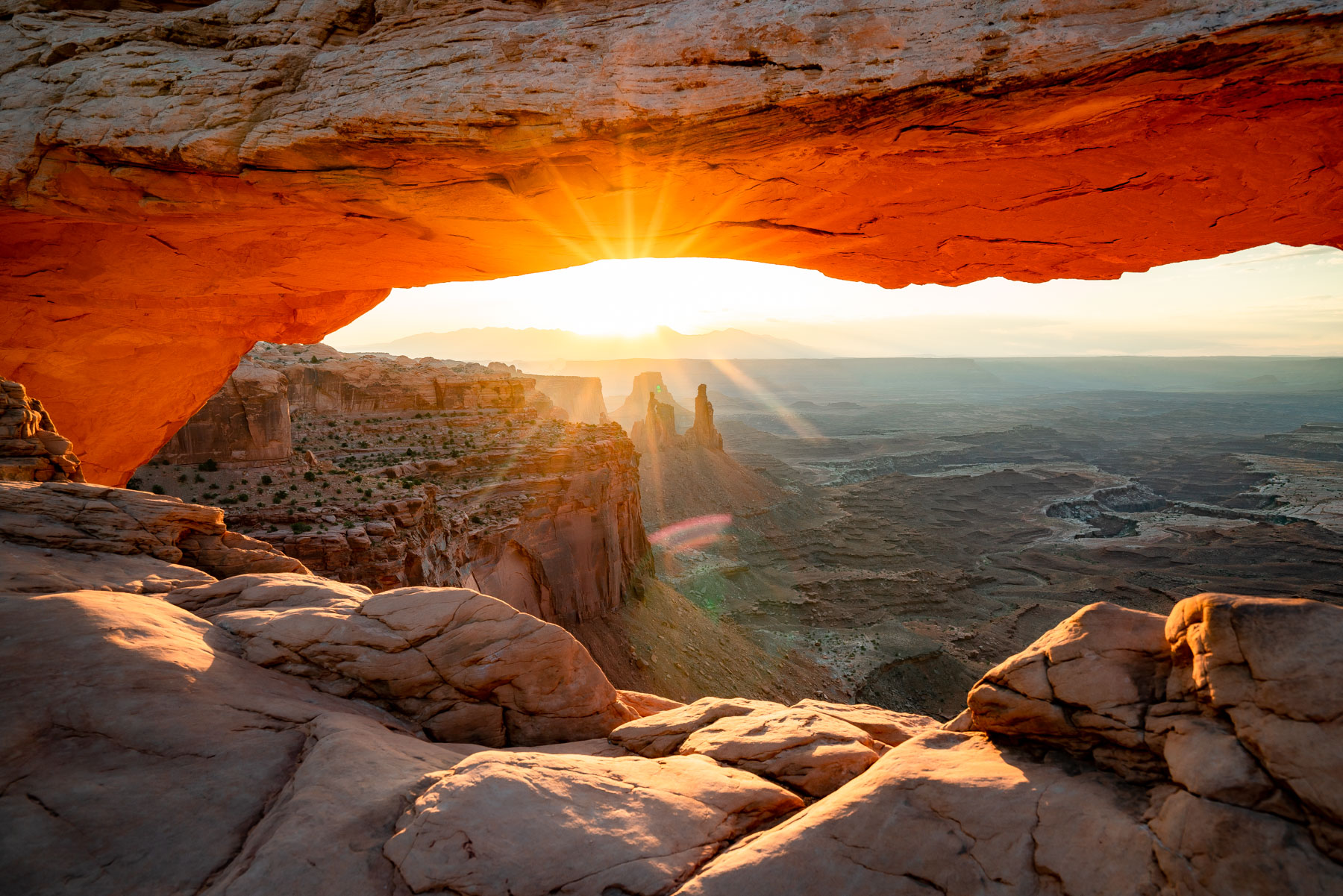
Article Overview: Utah National Parks
Planning a trip to the Utah national parks are we? Or perhaps you’re just interested in learning more about the mighty five. Either way, you’ve come to the right place. As the co-founder of More Than Just Parks I’ve visited the Utah national parks more than 30 times over the past decade and spent countless hours within them. I have a deep love and respect for these places.
After receiving the hundredth request for Utah national park trip planning information, I figured it was time to finally write an article spilling the beans on everything I’ve learned about them. When you see the photos of these places you can’t help but want to go.
Utah’s national parks are among the most visited, most scenic, and most photographed in the world – and for good reason! From the Hoodoos of Bryce Canyon to the vastness of Canyonlands, from the grandeur of Zion to the lonesome vistas of Capitol Reef, Utah’s national parks have something for everyone.
Ready to get started? Let’s go!

Map of the Utah National Parks

Utah National Parks
Table of Contents: Utah National Parks
Table of Contents: Utah National Parks
- Map of the Utah National Parks
- Utah National Parks
- FAQ – Utah National Parks
- The Mighty 5 Utah National Parks
- 8 Day Utah National Parks Itinerary: Utah Road Trip Route
- Day 1 Utah National Parks Itinerary: Salt Lake City to Moab + Arches Sunset (3.5hrs drive)
- Day 2 Utah National Parks Itinerary: Arches & Canyonlands
- Day 3 Utah National Parks Itinerary: Canyonlands to Capitol Reef (3hrs)
- Day 4 Utah National Parks Itinerary: Capitol Reef & Bryce Canyon
- Day 5 Utah National Parks Itinerary: Bryce Canyon National Park
- Day 6 Utah National Parks Itinerary: Zion National Park
- Day 7 Itinerary: Zion National Park
- Day 8 Itinerary: Cedar City to Salt Lake City (3.5 hours)
- Ever Considered the 5 Utah National Forests?
- Map of Utah’s National Parks
- List of Utah National Parks (Summary)
FAQ – Utah National Parks
The Utah Mighty 5 national parks are: Arches National Park, Bryce Canyon National Park, Canyonlands National Park, Capitol Reef National Park, & Zion National Park
There are five national parks in the state of Utah.
Zion is the most visited national park in Utah receiving 5,039,835 last year.
The Mighty 5 Utah National Parks

1. Arches National Park, Utah
Location: Moab, Utah
Size: 76,679 acres
MTJP Score: 37.5
- Accessibility – 7/10
- Recreation – 7/10
- Crowds – 7/10
- Amenities – 8/10
- Scenery – 8.5/10
Arches National Park Resources
Things to Do: Things to Do in Arches National Park
Hikes: Best Hikes in Arches National Park
Facts: Interesting Facts About Arches National Park
Map: Map of Arches National Park
Guidebook: Arches National Park Guidebook
Lodging: Where to Stay in Arches National Park
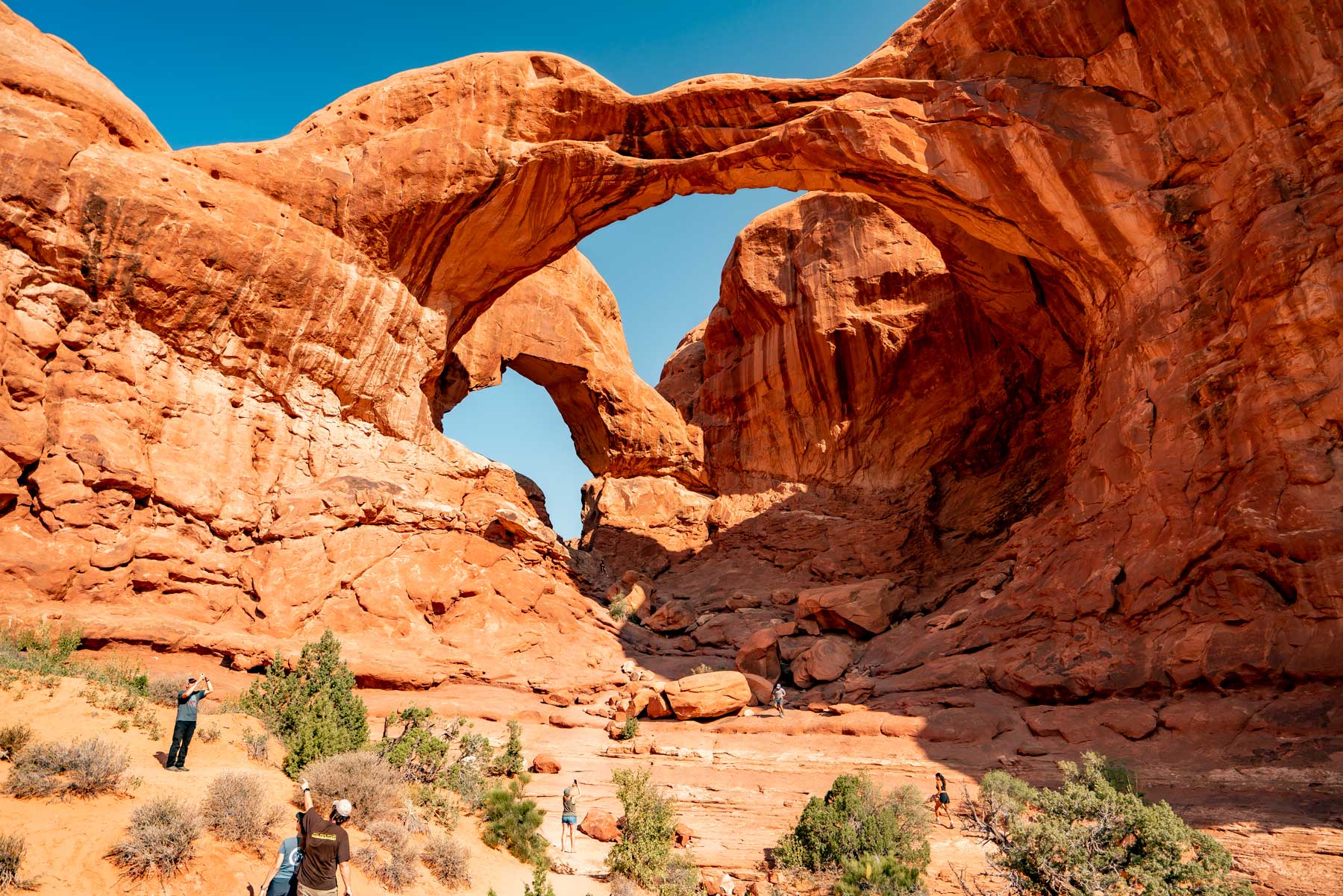
Visiting Arches National Park
Arches National Park is located in southeastern Utah. It has more than 2,000 natural sandstone arches. There are also many other wondrous formations like giant stone bluffs, pinnacles, and red-rock canyons within this preserved area.
For thousand of years, Native Americans lived in this region. Arches was initially designated a national monument before being changed to a national park in 1971 by President Nixon.
It’s perhaps the most interactive of all the Utah parks filled with scenery that brings out the child in all of us.
Sandstone hallways and tunnels, rocks to climb on and over, sandy trails perfect for sandals or even bare feet at times, and red rock vistas that make for an unforgettable experience.
Did you know Arches National Park has the highest concentration of sandstone arches on the planet?
It’s close proximity to Moab does make it a bit of a crowded park at times so be sure to take advantage of early mornings when visiting and consider going during the shoulder seasons.
RELATED: Utah’s Fishlake National Forest: It’s Even More Magical Than You Know
Arches National Park Highlights

Delicate Arch is the iconic arch featured on the Utah license plate and the arch everyone plans their trip around. The hike up to Delicate Arch isn’t a walk in the park as it involves a solid incline and a bit of navigating the sandstone, but is more than doable for most visitors.
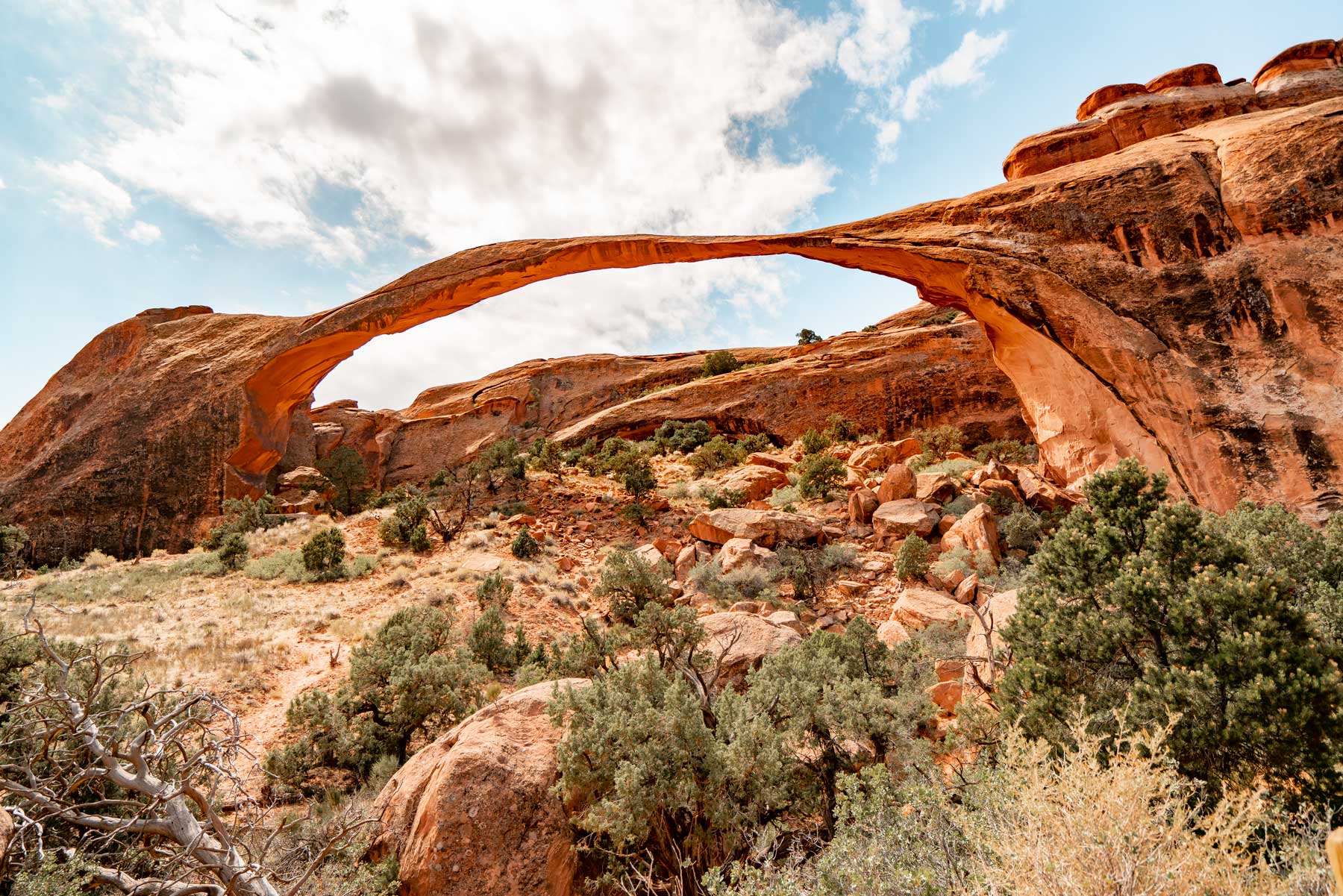
Landscape Arch is the largest arch on earth spanning some 306 feet of weathered sandstone. This one is an easy 1.5 miles round trip and a must on your Arches trip.
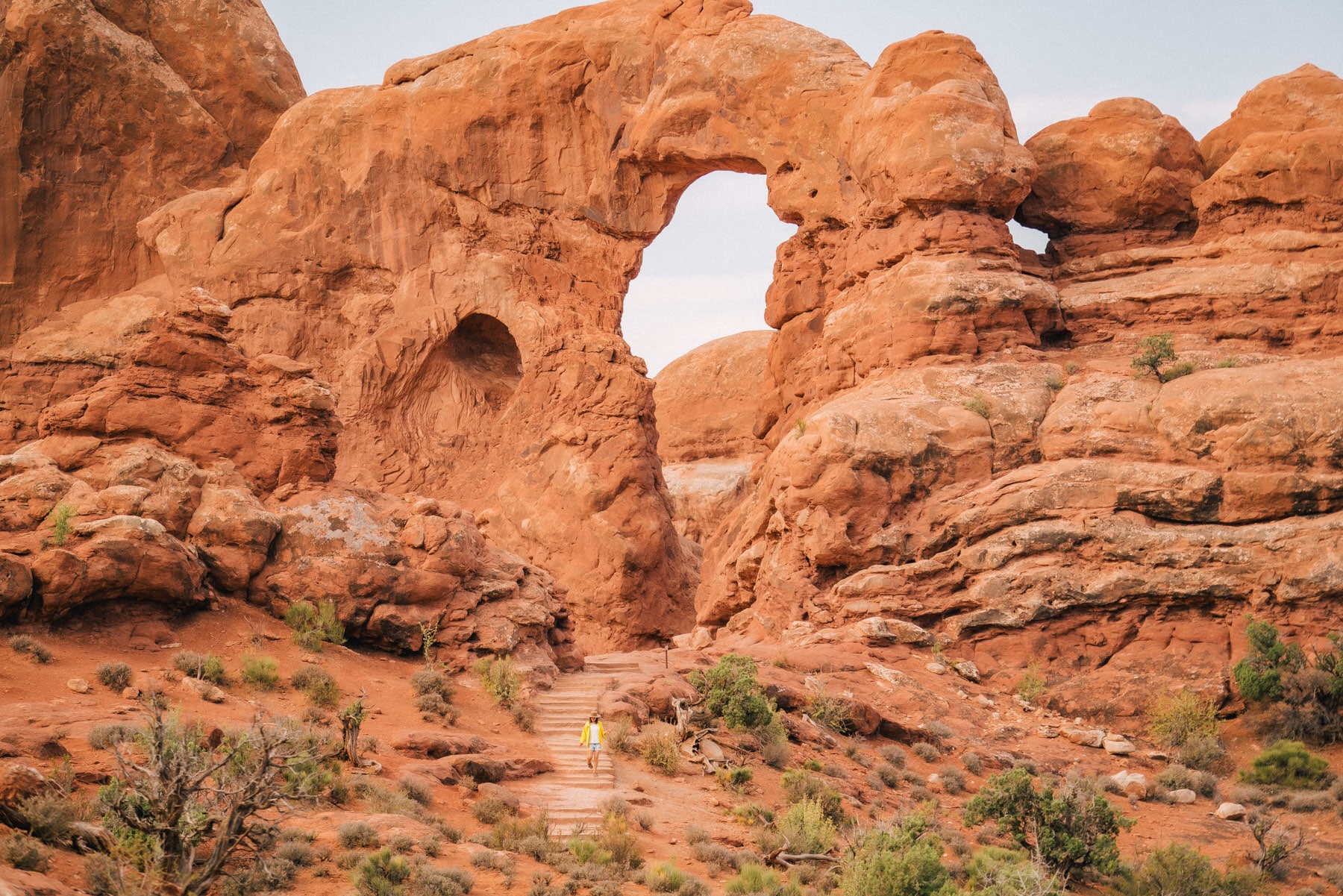
Double O Arch featured in the image above is a very unique arch on top of an arch. This 4.1 mile out and back hike is a bit more strenuous, especially in the summer heat, so plan accordingly and bring plenty of water.
Arches National Park Campgrounds
There’s only one campground in Arches National Park and that’s Devils Garden. If you don’t have reservations there you might as well not even try. Luckily the Moab area is full of BLM campgrounds where you’ll have much better odds.

2. Capitol Reef National Park, Utah
Location: Torrey, Utah
Size: 241,904 acres
MTJP Score: 37
- Accessibility – 6.5/10
- Recreation – 7/10
- Crowds – 9/10
- Amenities – 7/10
- Scenery – 7.5/10
Capitol Reef National Park Resources
Things to Do: Best Things to Do in Capitol Reef National Park
Facts: Interesting Facts About Capitol Reef National Park
Map: Map of Capitol Reef National Park
Guidebook: Capitol Reef National Park Guidebook
Where to Stay: Where to Stay in Capitol Reef National Park
Visiting Utah’s Capitol Reef National Park
Probably the least known Utah national park, and yet it’s easily one of the best.
No crowds, abundant scenery, and there’s even a small town (Torrey) nestled up against the park that has restaurants and conveniences that will surprise you.
Lots of great day-hikes and truly out of this world stargazing opportunities (pun intended).
Overlooks that look out on vast and lonely landscapes shaped by geological activity over millennia, uncrowded trails through ancient petroglyphs, natural arches, and beautiful red rock scenery, and historic structures preserving early pioneer life.
What’s not to like about this often-overlooked Utah gem?
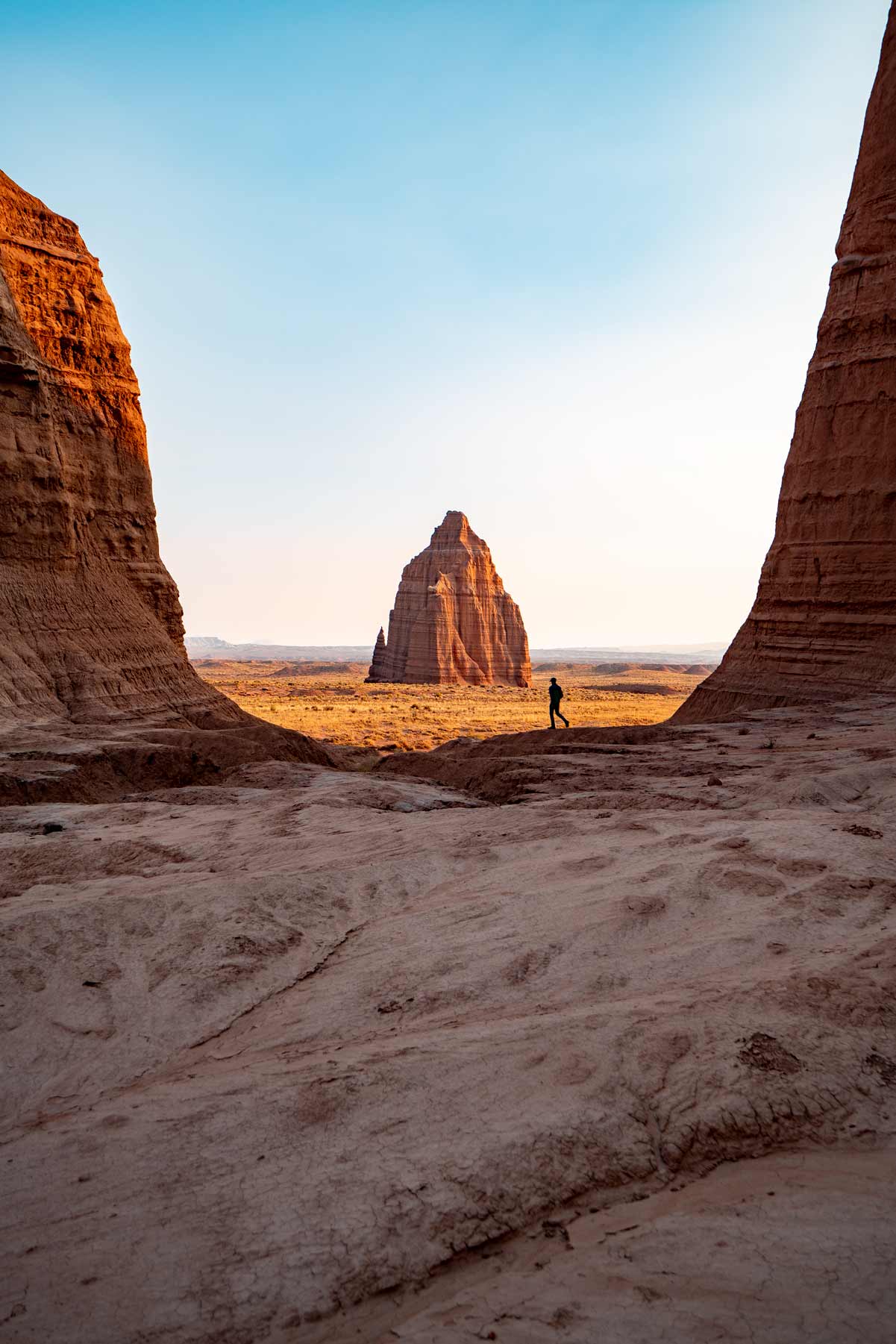
RELATED: Manti-La Sal National Forest: The Forest As Beautiful as Utah’s Parks
Capitol Reef National Park Highlights
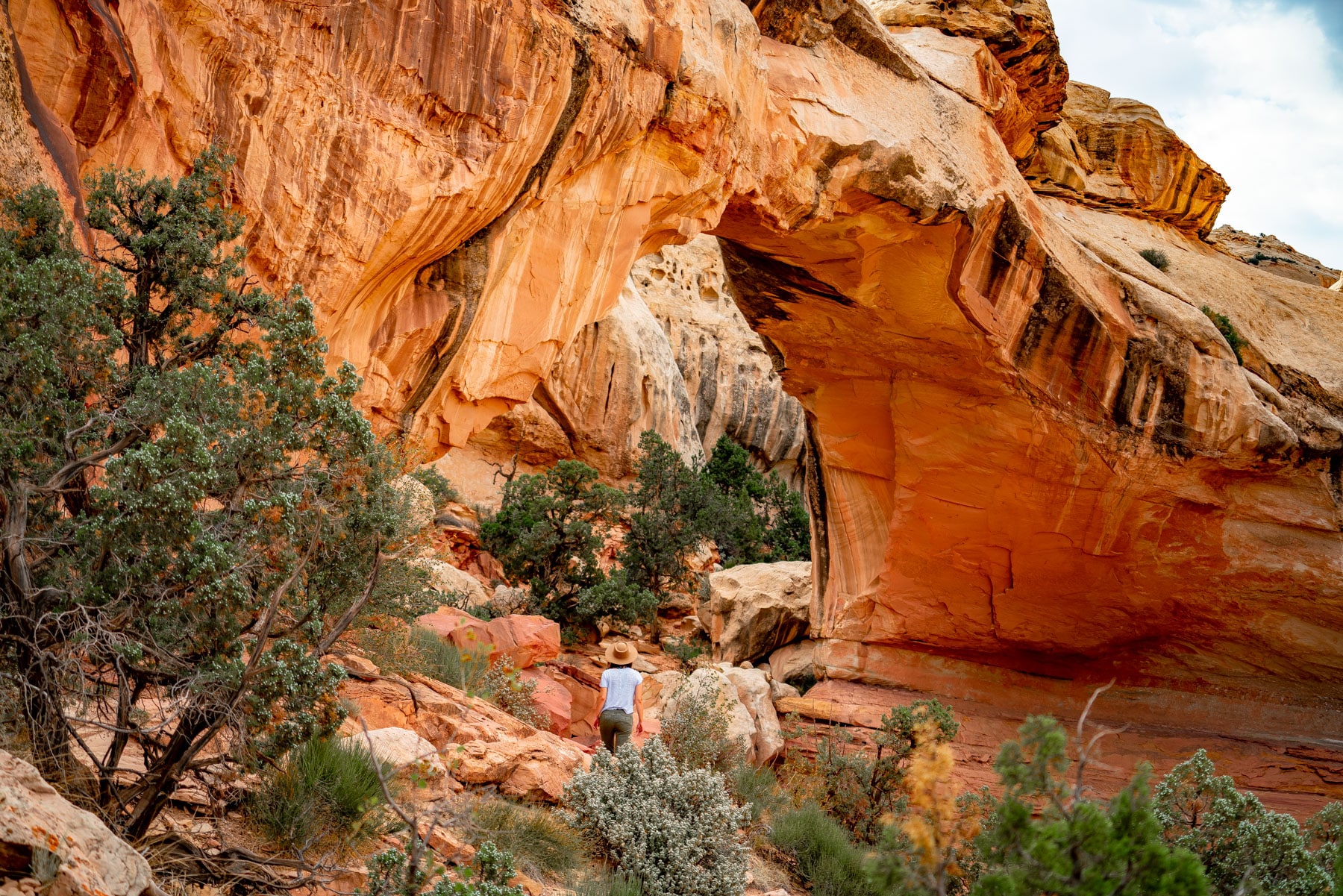
Hickman Bridge is an easy 2 mile trail (1 mile each way) taking you to a spectacular sandstone arch. The trail also takes you by early Fremont ruins and a smaller arch.
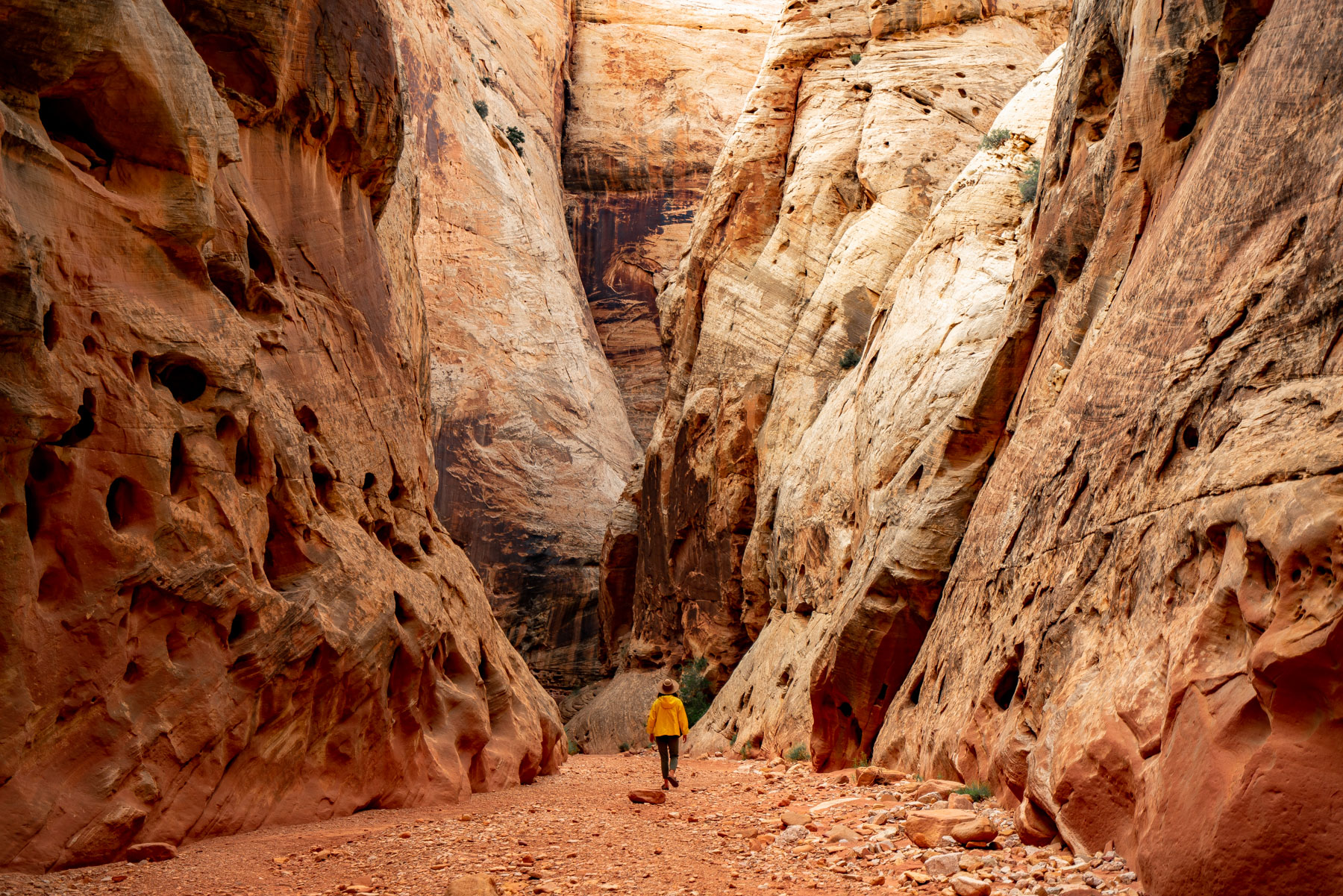
Grand Wash is an spectacular gorge that cuts through the Capitol Reef’s Waterpocket Fold geological formation. The trail follows a flat wash for just over 6 miles, but most visitors prefer to explore the half mile narrows (featured in the image above) before simply turning back.
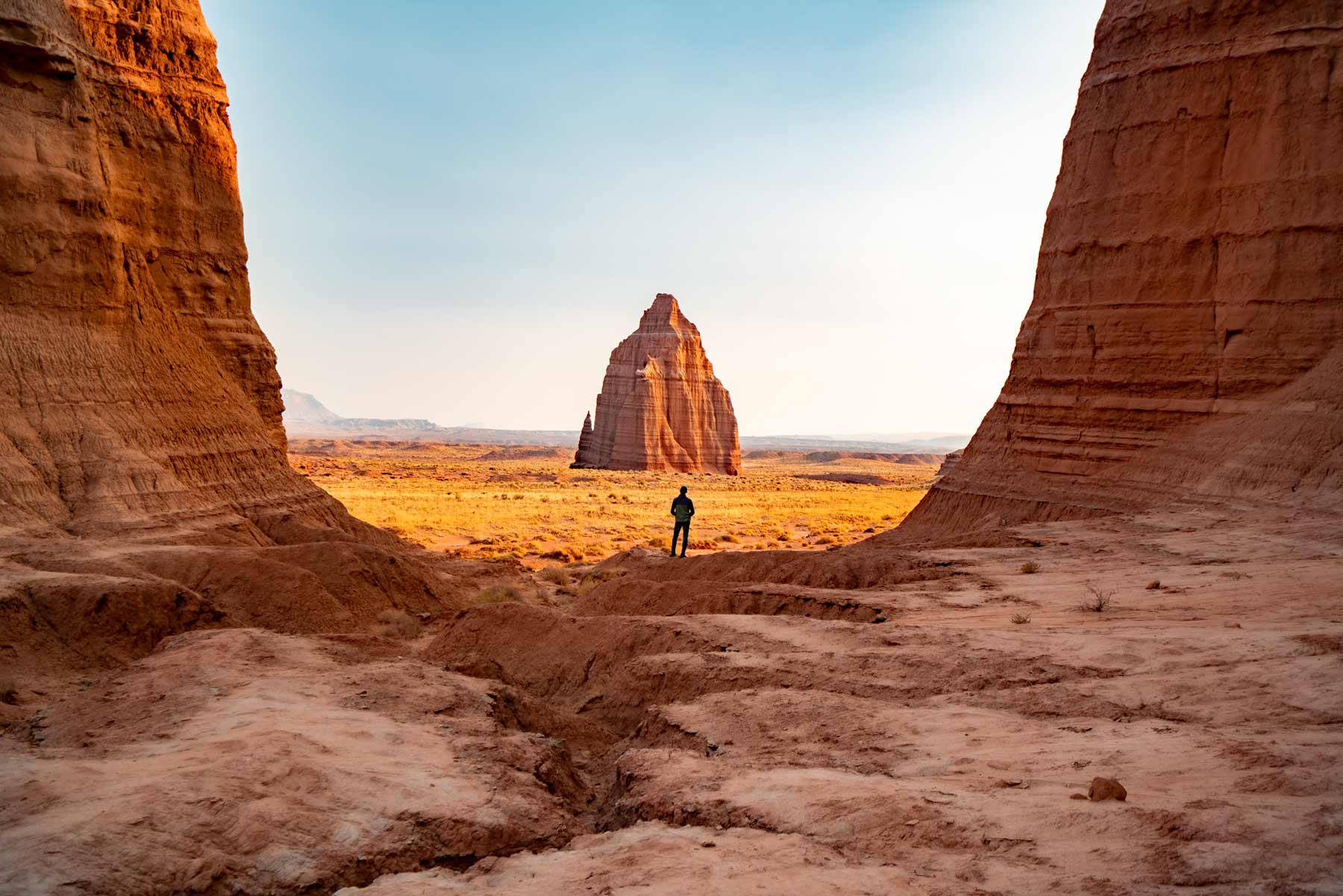
Lower Cathedral Valley is one of the most beautiful places in all of the Utah national parks featuring the famous temples of the sun and moon.
Stargazing Capitol Reef was designated an International Dark Sky Park back in 2015 and for very good reason. The night skies over Capitol Reef provide some of the best stargazing opportunities in the United States.

3. Zion National Park, Utah
Location: Springdale, Utah
Size: 146,597 acres
MTJP Score: 38*
- Accessibility – 9/10
- Recreation – 10/10
- Crowds – 0.5/10
- Amenities – 9.5/10
- Scenery – 9/10
Guide: Comprehensive Guide to Zion National Park
Things to Do: Best Things to Do in Zion National Park
Hikes: Best Hikes in Zion National Park
Facts: Interesting Facts About Zion National Park
Map: Map of Zion National Park
Guidebook: Guidebook to Zion National Park
Lodging: Where to Stay in Zion National Park

Visiting Utah’s Zion National Park
Zion National Park is unlike anywhere else on the planet. Looking up at those impossibly big canyon walls for the first time is a feeling you don’t ever forget.
Now, you might be scratching your head as to why Zion is ranked number three despite having the highest score of any park on this list. The answer is simple, the crowds.
Listen folks, we love Zion, but the truth is this park is a mess these days. We hear a lot about our national parks being “loved to death” and no park epitomizes this problem more than Zion.
While the park is jaw-droppingly beautiful and home to world-class recreational opportunities, it’s also completely choked with tourists on every trail and crowding every vista.
Buses, lottery systems, permits, closures, and still the crowds swarm like moths to a flame. What’s that old proverb? If you love it, let it go.
We rank Zion number three on this list despite it having the highest actual score because we can’t in good faith rank it as the best Utah National Park right now – it simply isn’t.
Unfortunately our ranking system just can’t take into account the fact that the visitor experience in Zion is a disaster right now – and it’s because of us, the people continuing to crowd it in spite of all the warnings.
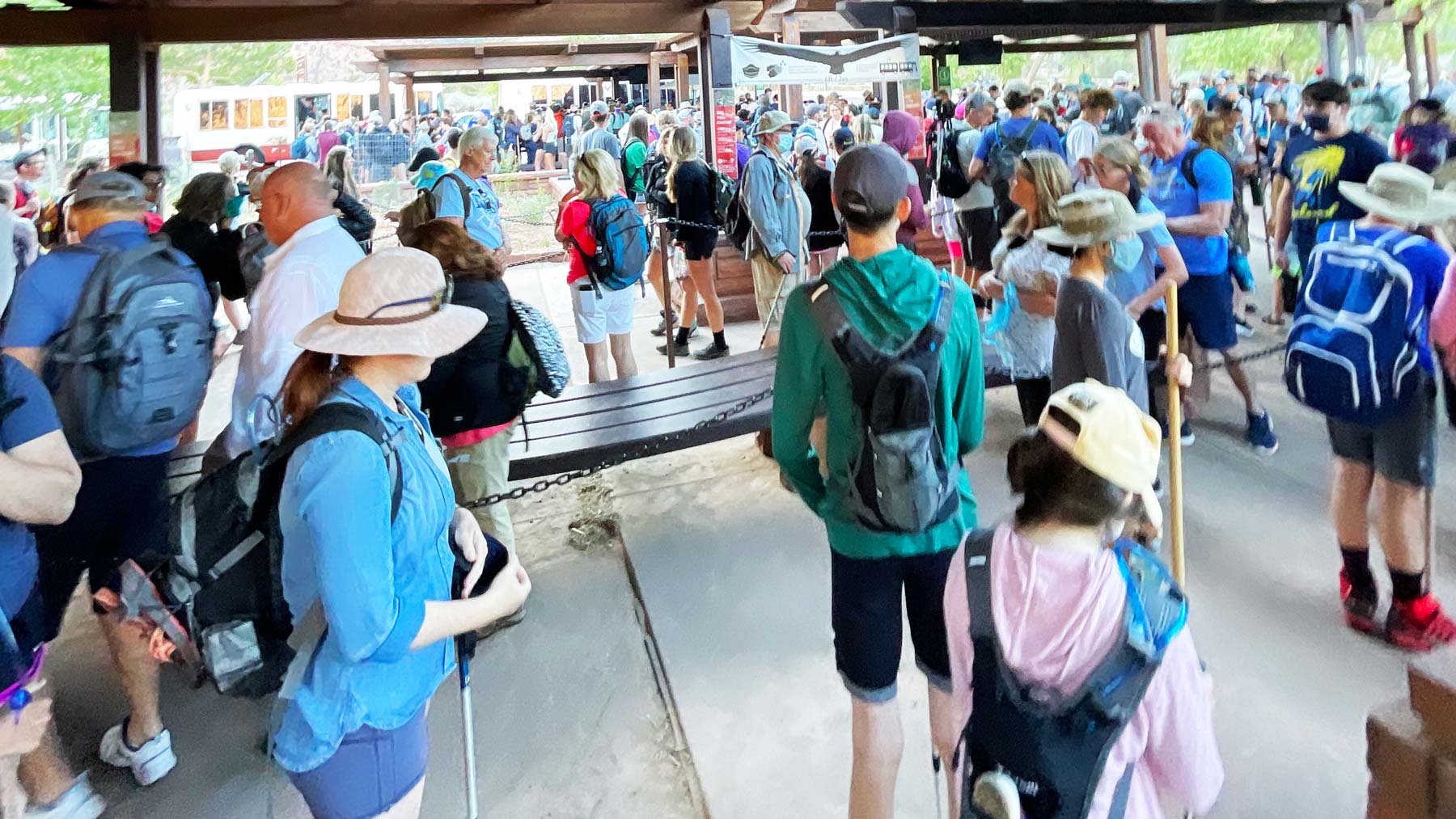
The Crowds at Zion National Park
All that said, there actually are a few areas of the park that are not completely overrun, like Kolob Terrace and Kolob Canyons.
In those separate parts of the park you can actually enjoy the beauty of the place without the near constant head-shaking necessitated by seeing the endless crowds of tourists desperately angling for their next social media masterpiece.
RELATED: 11 BREATHTAKING Things to Do in Zion National Park
Zion National Park Highlights
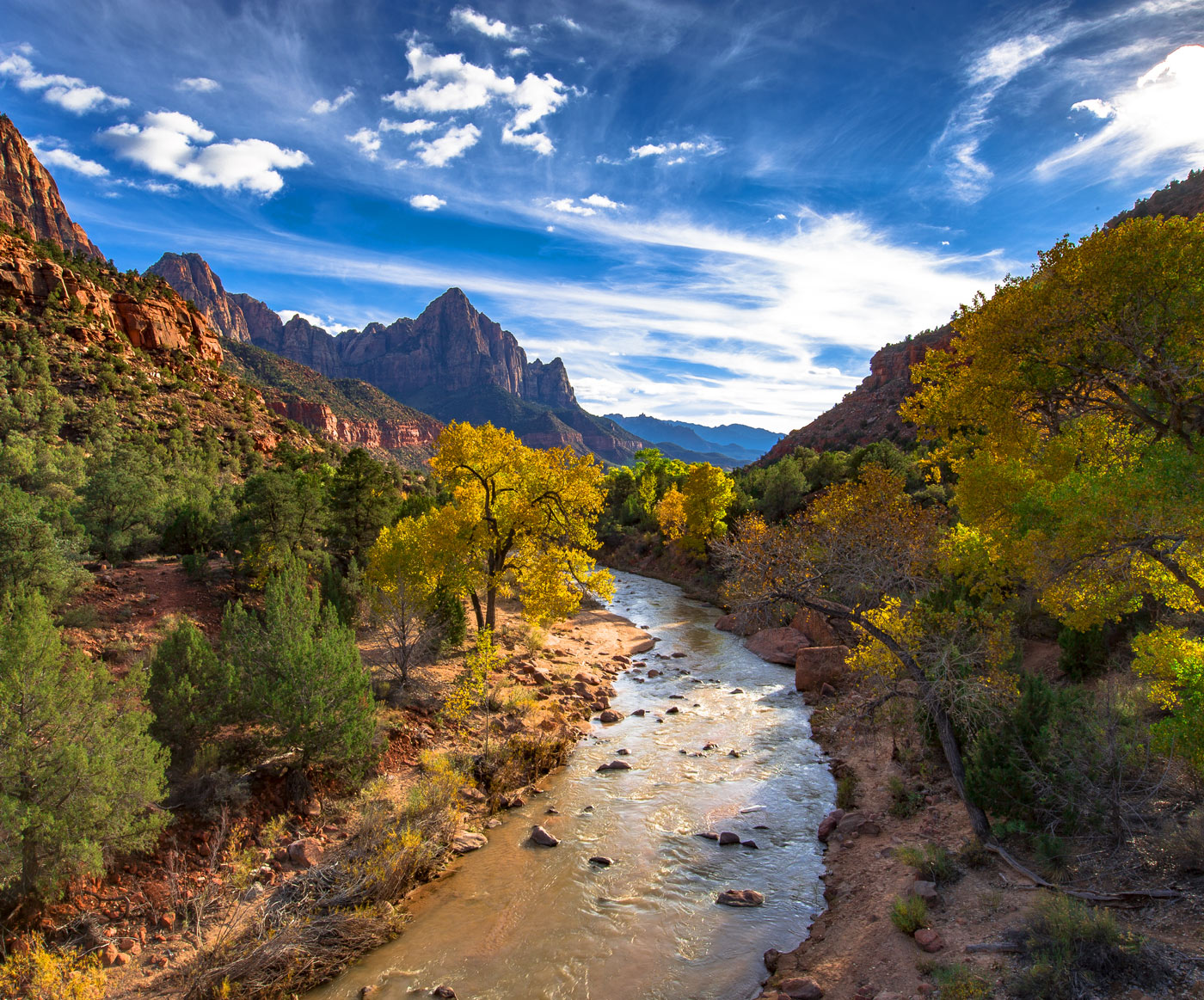
The Watchman is probably the most iconic feature of the park. This sandstone mountain juts out from the familiar cliffs of Zion and looks out over the whole park. It’s best seen from the bridge near the entrance to the main canyon.
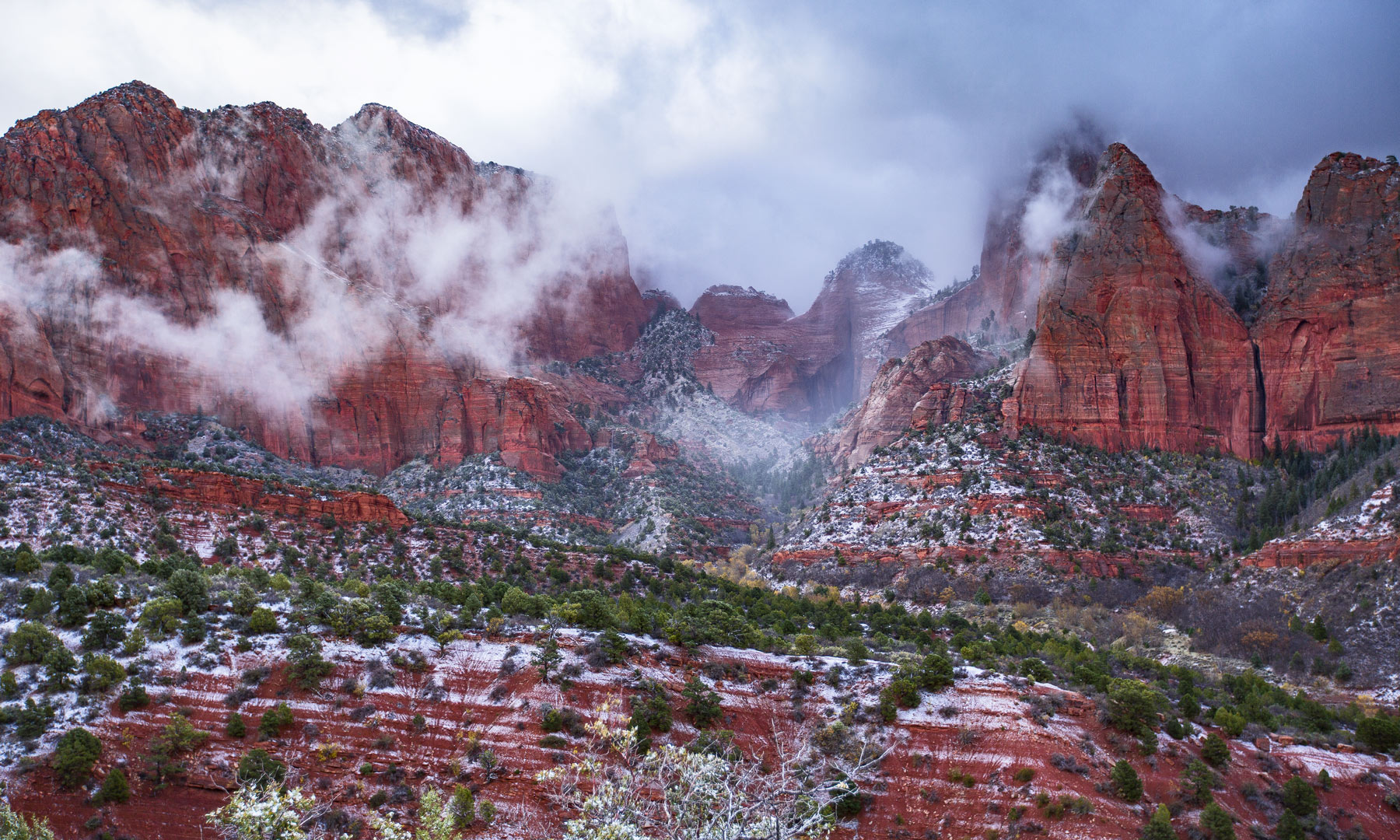
Kolob Canyon is our favorite part of the park, where you can escape the maddening crowds and explore the scenery that makes this area of Utah so treasured.
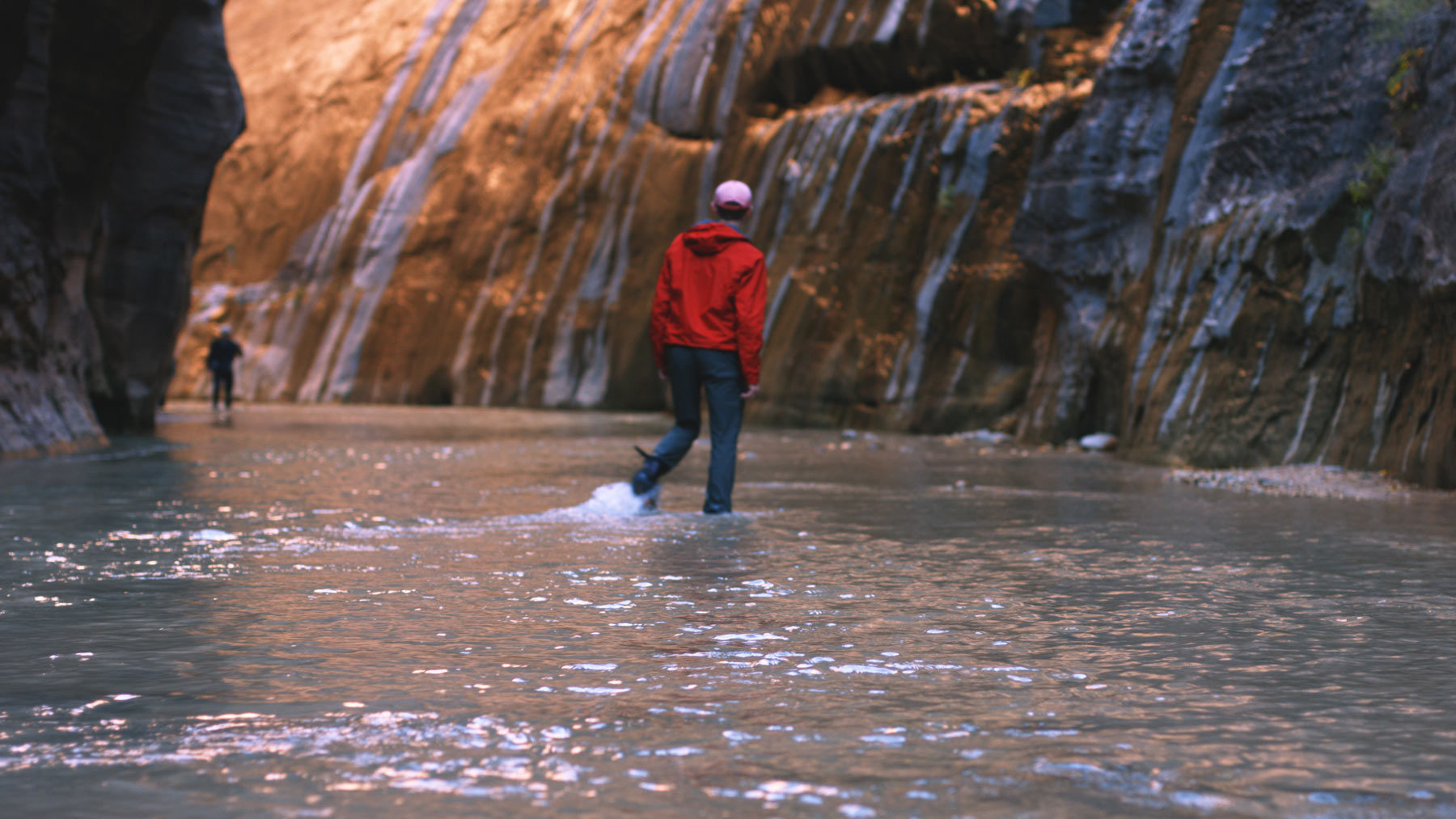
The Narrows is one of the absolute coolest hikes in Zion National Park and the entire national park system for that matter. Hikers hike, walk, and wade through a narrow canyon of massive red rock canyon walls where the Virgin River has been at work for millions of years.
Distance: 16 miles (but most only hike the first few miles which are incredible)
Time: Typically 2-3 hours depending on how far you go
You’ll need some good water shoes for this hike and a hiking pole is recommended although most folks go without (water shoes can be rented in Springdale at a number of places).
Watch the Award-Winning Zion National Park Video
Zion National Park Guide
Interested in learning more about Zion National Park? We made a beautiful and easy to use guide with helpful tips, photos, video, & more! See our Zion National Park Guide.
4. Canyonlands National Park, Utah
Location: Moab, Utah
Size: 337,598 acres
MTJP Score: 37
- Accessibility – 5.5/10
- Recreation – 8.5/10
- Crowds – 8.5/10
- Amenities – 7/10
- Scenery – 9/10
Canyonlands National Park Resources
Things to Do: Things to Do in Canyonlands National Park
Hikes: Best Hikes in Canyonlands National Park
Facts: Interesting Facts About Canyonlands National Park
Map: Map of Canyonlands National Park
Guidebook: Canyonlands National Park Guidebook
Lodging: Our Favorite Hotel for Canyonlands National Park

Visiting Canyonlands National Park
Canyonlands is one of the parks that has views that one can seemingly gaze upon for days without losing interest or comprehending exactly the vastness of the landscape.
Mesa Arch here represents one of the most photographed sunrises in all of the national park system and Green River overlook one of the most dazzling sunsets.
The catch? Four-wheel drive.
If you’ve got it you’re set and have full access to all of the unbelievable destinations the park has to offer.
Without it, your time in the park will be mostly limited to overlooks from above, which are still well worth the trip.

Canyonlands Highlights

Mesa Arch is the most photographed feature in the park and is where you’ll find the bulk of tourists looking to snag their very own photo of this arch with a view. Sunrise is the best time to head over and see the sun makes its way up through the arch while illuminating the vast landscape.
The Needles makes up the southeastern corner of the park and is named after the multi-colored spires of sandstone that dominate the area. The Needles area offers a multitude of hiking opportunities as well as 4WD roads leading to fascinating ruins.
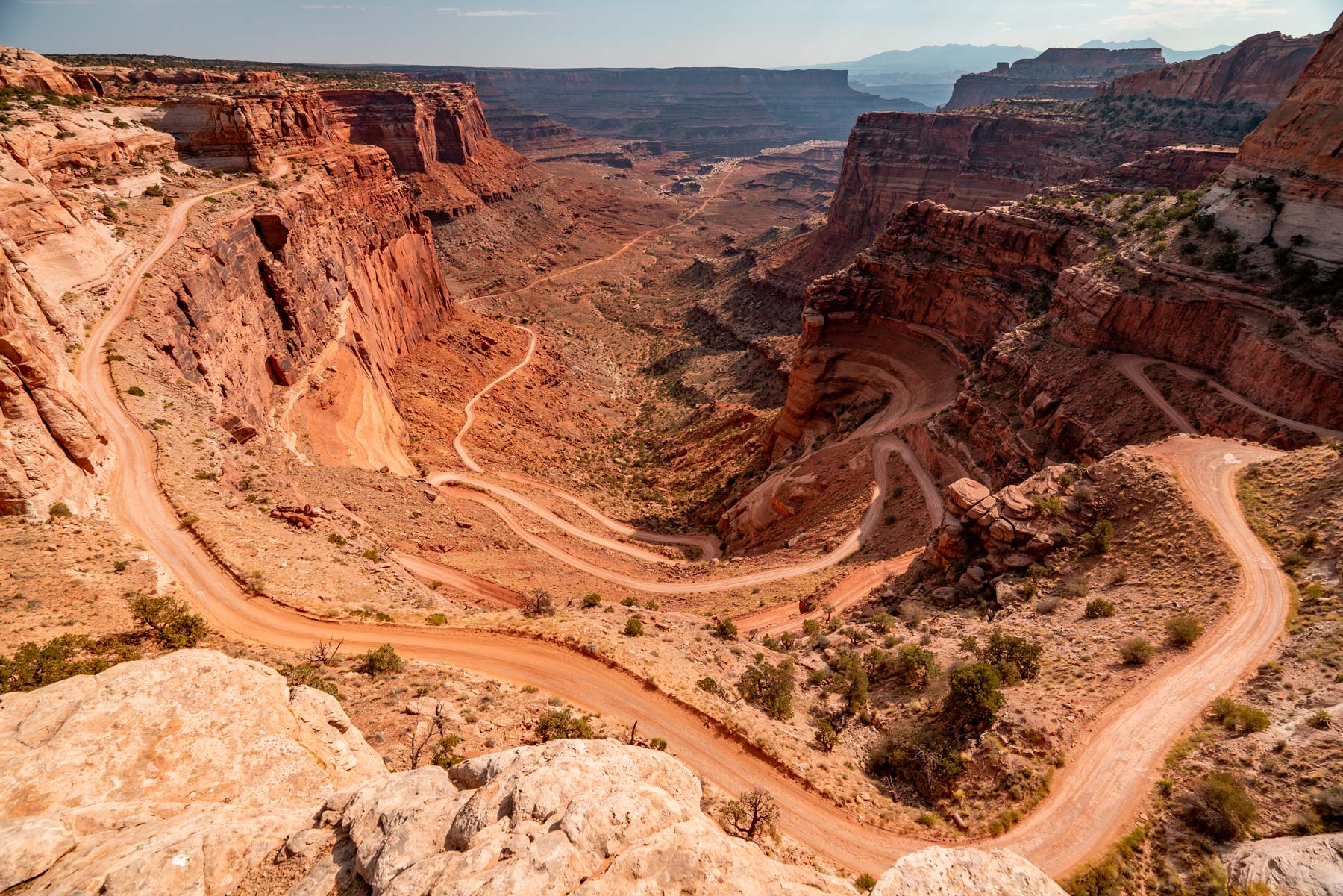
Shafer Canyon Road is perhaps the pinnacle of 4WD roads in the United States. Here you can put your high clearance four-wheel-drive SUV through the wringer on this challenging, unpaved, and downright scary road.

5. Bryce Canyon National Park, Utah
Location: Central Utah
Size: 35,835 acres
Score: 37
- Accessibility – 6.5/10
- Recreation – 6.5/10
- Crowds – 7/10
- Amenities – 9/10
- Scenery – 8/10
Bryce Canyon National Park Resources
Things to Do: Things to Do in Bryce Canyon National Park
Facts: Interesting Facts About Bryce Canyon National Park
Map: Our Favorite Map of Bryce Canyon National Park
Guidebook: Our Favorite Guidebook for Bryce Canyon National Park
Lodging: Our Favorite Hotel for Bryce Canyon
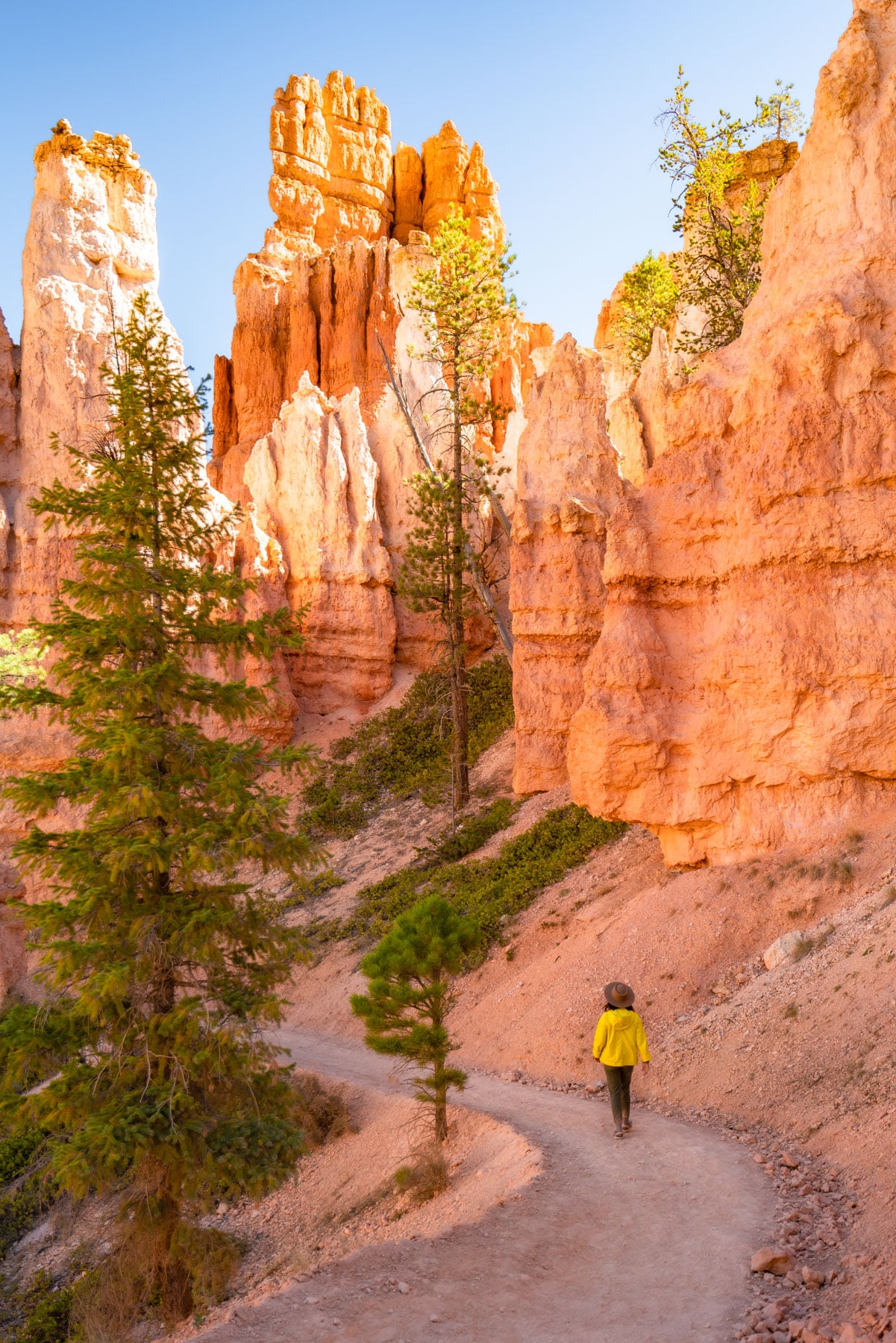
Visiting Bryce Canyon National Park
As far as the mighty 5 Utah national parks go, Bryce Canyon clocks in at number 5 on the list.
I’ll be the first to say that the Navajo Loop Trail in Bryce Canyon is among the most beautiful I’ve hiked in the parks system.
Sunrises in the park are nothing short of jaw-dropping. Some of the famous hoodoos in Bryce Canyon are more than 200 feet tall!
However, the scenery here, while beautiful, doesn’t really change past the main viewing area near Sunset Point. Add the crowds here which are tour bus large, with the relative small size of the park and we arrive at 5 out of 5.
With that being said, even Utah’s lowest ranking park still ranks higher than most other parks.
Bryce Canyon Highlights
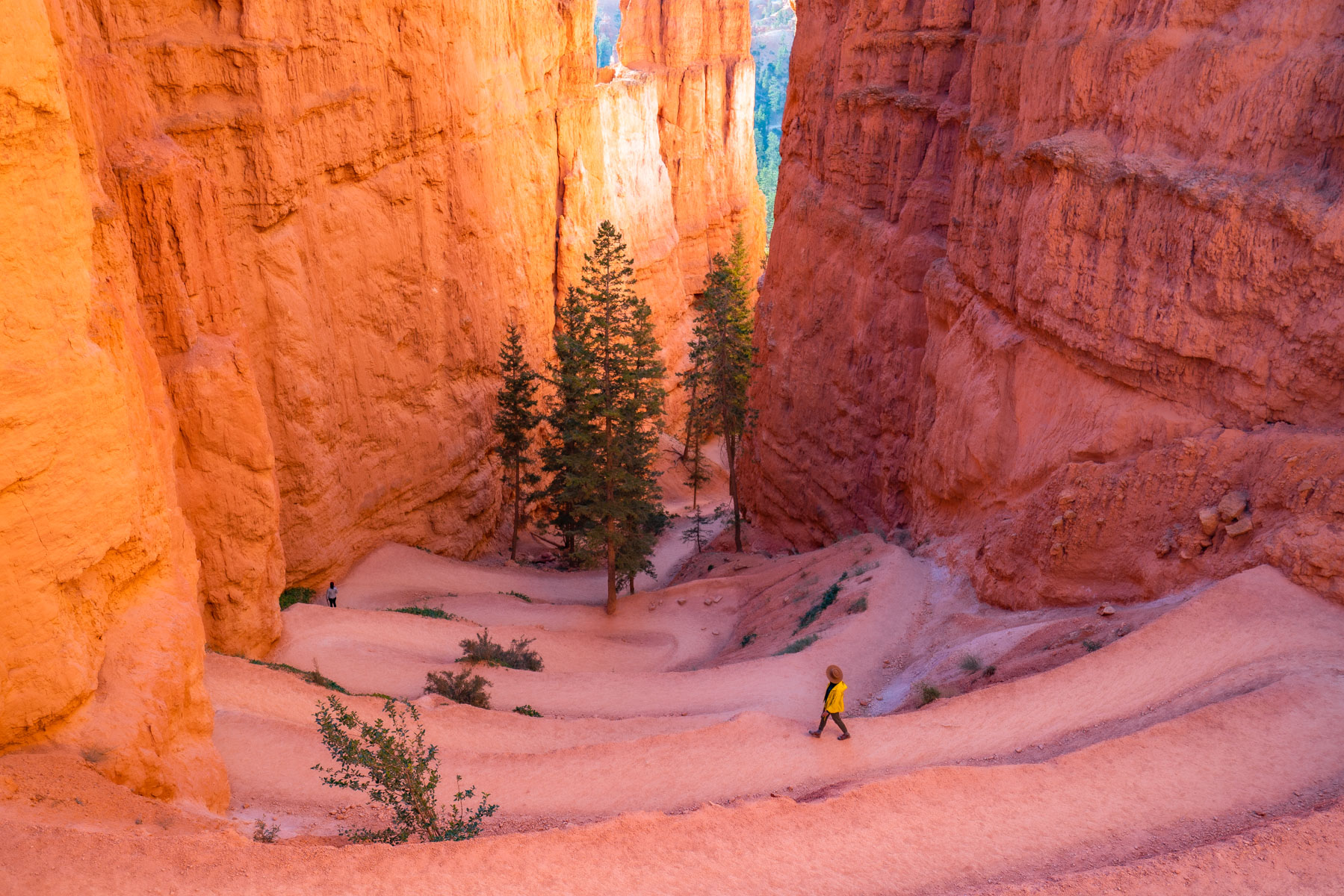
Wall Street Trail is a spectacular trail through Bryce Canyon’s famous otherworldly scenery. It’s one of my top five favorite trails in the Utah national parks.

Sunset Point is the quintessential Bryce Canyon overlook where visitors are amazed at the mind-bending beauty and concentration of hoodoos and rock formations. As it’s name suggests, sunsets here are not to be missed.

Inspiration Point has a fitting name – from here you can look out on the vast landscape that makes up this unique portion of Utah. Hoodoos, mesas, ponderosa pines, cedar, and beautifully striped hills as far as the eye can see.
Camping at Bryce Canyon National Park
More Utah National Parks & Monuments
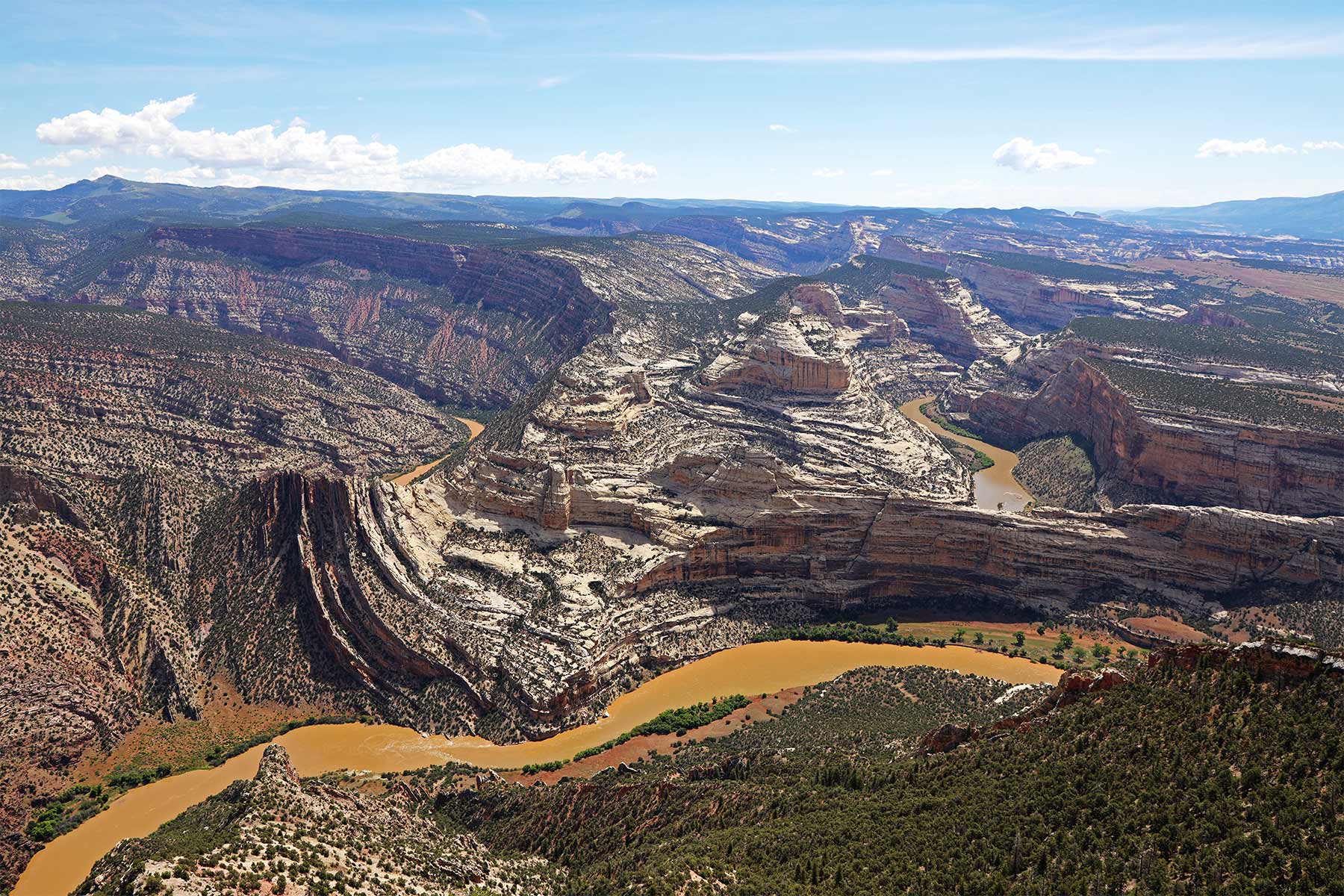
6. Dinosaur National Monument
Location: Colorado & Utah, USA
Best Resources: Map | Guidebook
Managed By: NPS
Size: 210,844 acres
Established: 1915
About Dinosaur National Monument
What a hidden gem straddling the remote northern corners of two states, Colorado and Utah. The common refrain here is that if you’re interested in dinosaurs you’ll love this monument – which is true, but it vastly undersells this sprawling and immensely beautiful monument.
In addition to the famous dinosaur quarry and countless immaculately preserved dinosaur bones and skulls from various species, the park is home to over 200,000 acres of outdoor grandeur.
Here you can peer into the depths of stunning red rock canyons, whitewater raft the world-class Green or Yampa rivers, explore historic cabins and ponder ancient petroglyphs, camp out under a star-studded sky, and of course hike numerous trails venturing into the rugged and beautiful surroundings.
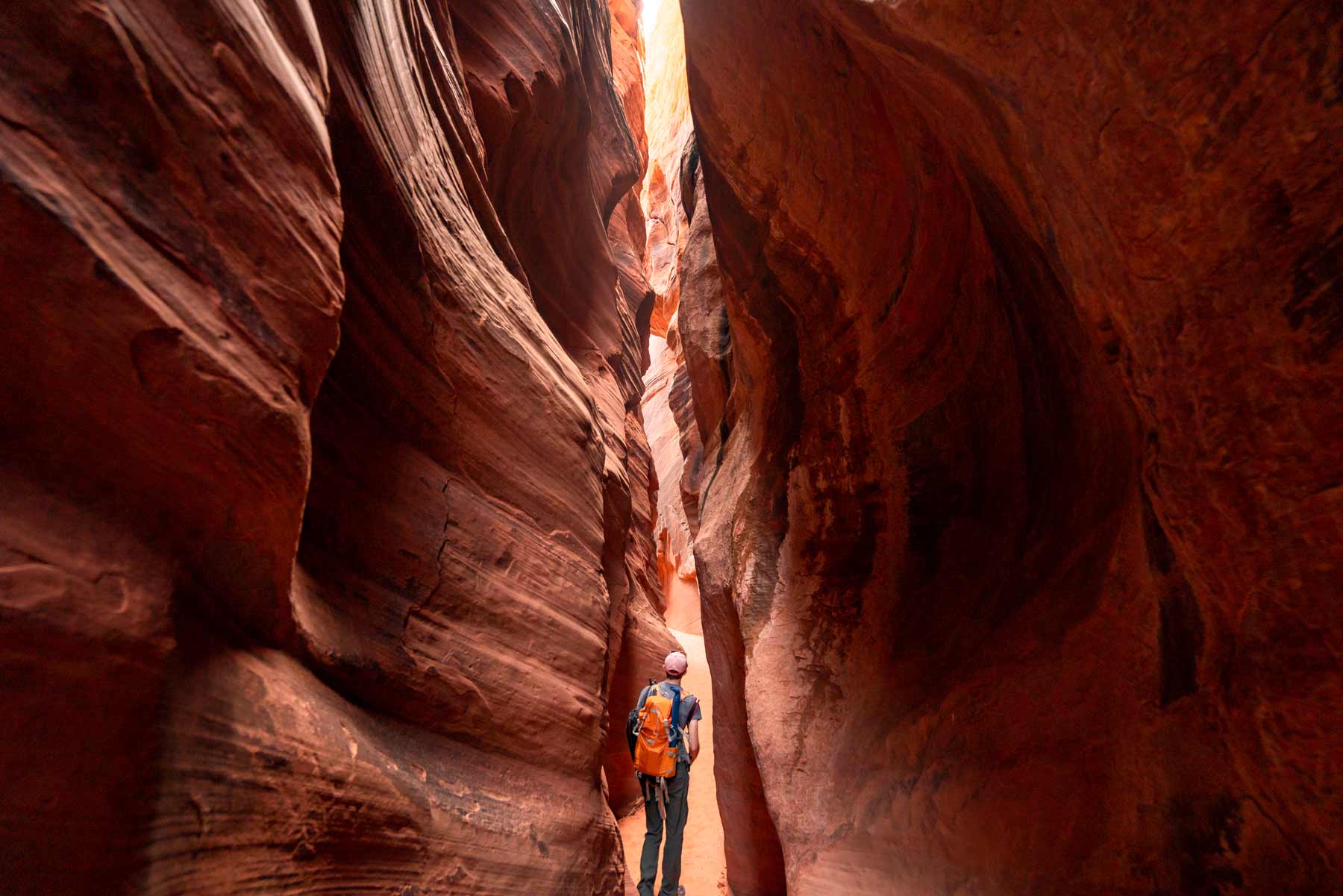
7. Grand Staircase-Escalante National Monument
Location: Utah, USA
Best Resources: Guidebook / Map
Managed By: BLM
Size: 1,870,000 acres
Established: September 18, 1996
Overall Score: 42/50
At 1.87 million acres Grand Staircase-Escalante Monument is more than double the size of all 5 of Utah’s National Parks combined and every bit as spectacular. This awe-inspiring, Rhode Island-sized national monument is a 200 million year old red rock cathedral of time.
Vast canyons, striking cliff-faces, rugged desert wilderness, and ancient history collide here making for an epic southwestern mecca. The “staircase” steps thousands of feet over five different life zones from coniferous forests to low-lying desert revealing millions of years of truly awesome geological history.
Recreation opportunities here are seemingly endless including hiking, biking, fishing, canyoneering, climbing, rappelling, swimming, camping, backpacking, and so much more.
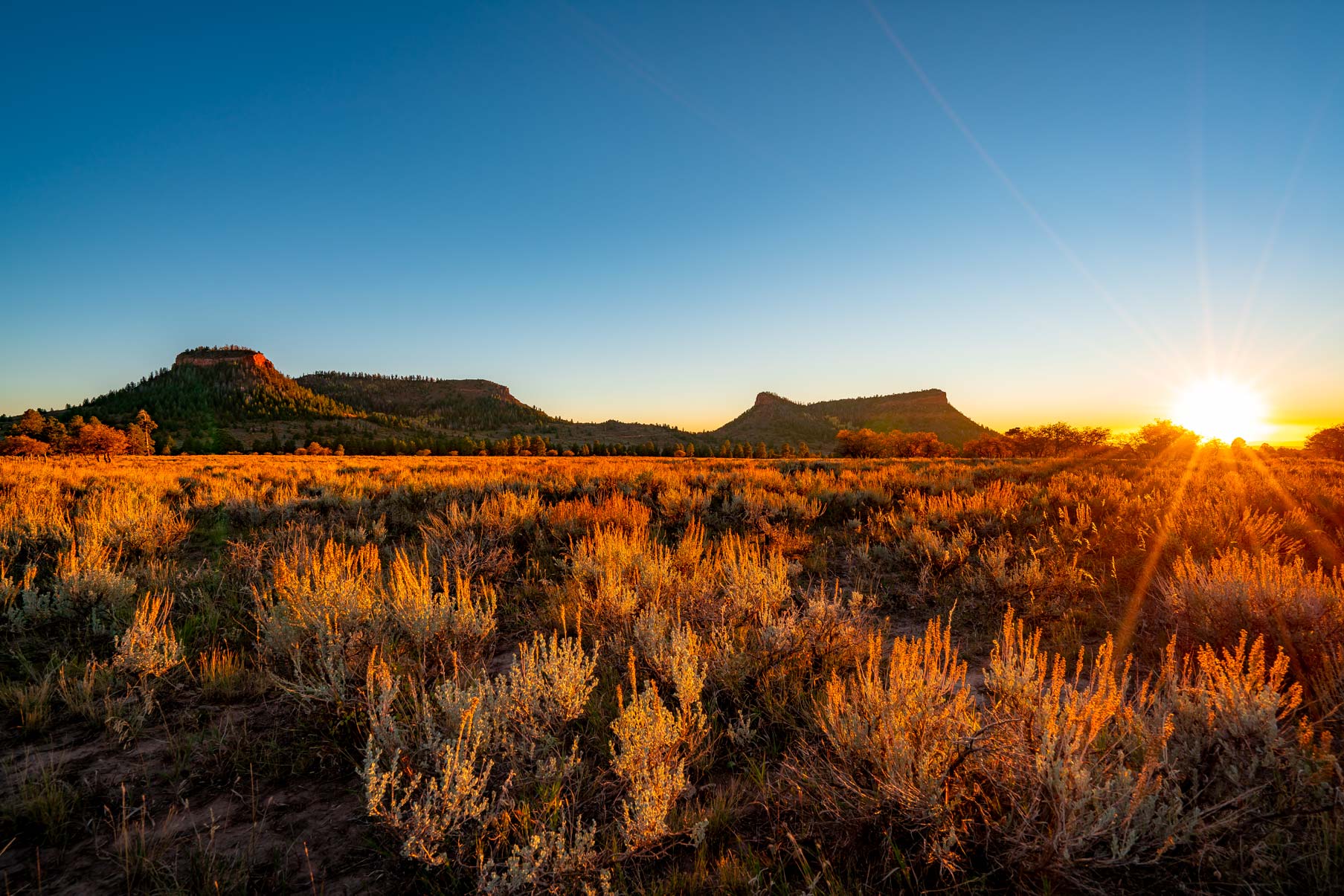
8. Bears Ears National Monument
Location: Utah, USA
Best Resources: Guide | Map
Managed By: USFS, BLM
Size: 1,360,000 acres
Established: December 28, 2016
Overall Score: 38/50
As one of the many premier outdoor destinations in the state of Utah, Bears Ears National Monument should be on the bucket lists of every public lands enthusiast.
Bears Ears National Monument protects some of the most beautiful and unique lands in the southwest including both natural and cultural wonders.
I recall visiting this monument for the first time and being awed by the diversity of landscapes varying from red rock canyons to high desert plateaus, aspen groves to natural arches, and so much more.
The “bears ears” are actually two prominent buttes located next to each other that can be seen on the horizon for miles around.
Beyond the amazing scenery, there are a host of great recreational opportunities at Bears Ears including hiking, camping, backpacking, canyoneering, climbing, horseback riding, and more.

9. Natural Bridges National Monument
Location: Utah, USA
Best Resources:
Managed By: NPS
Size: 7,636 acres
Established: April 16, 1908
Overall Score: 35/50
One of the first few national monuments proclaimed by then President Theodore Roosevelt, Natural Bridges protects a beautiful swath of Utah desert that is home to some of the most spectacular natural bridges found anywhere in the world.
This very remote national monument is actually quite well developed with nice roads, trails, a visitor center, and campground.
Natural Bridges National Monument also provides vital habitat to the endangered California Condor which can be seen throughout the monument.
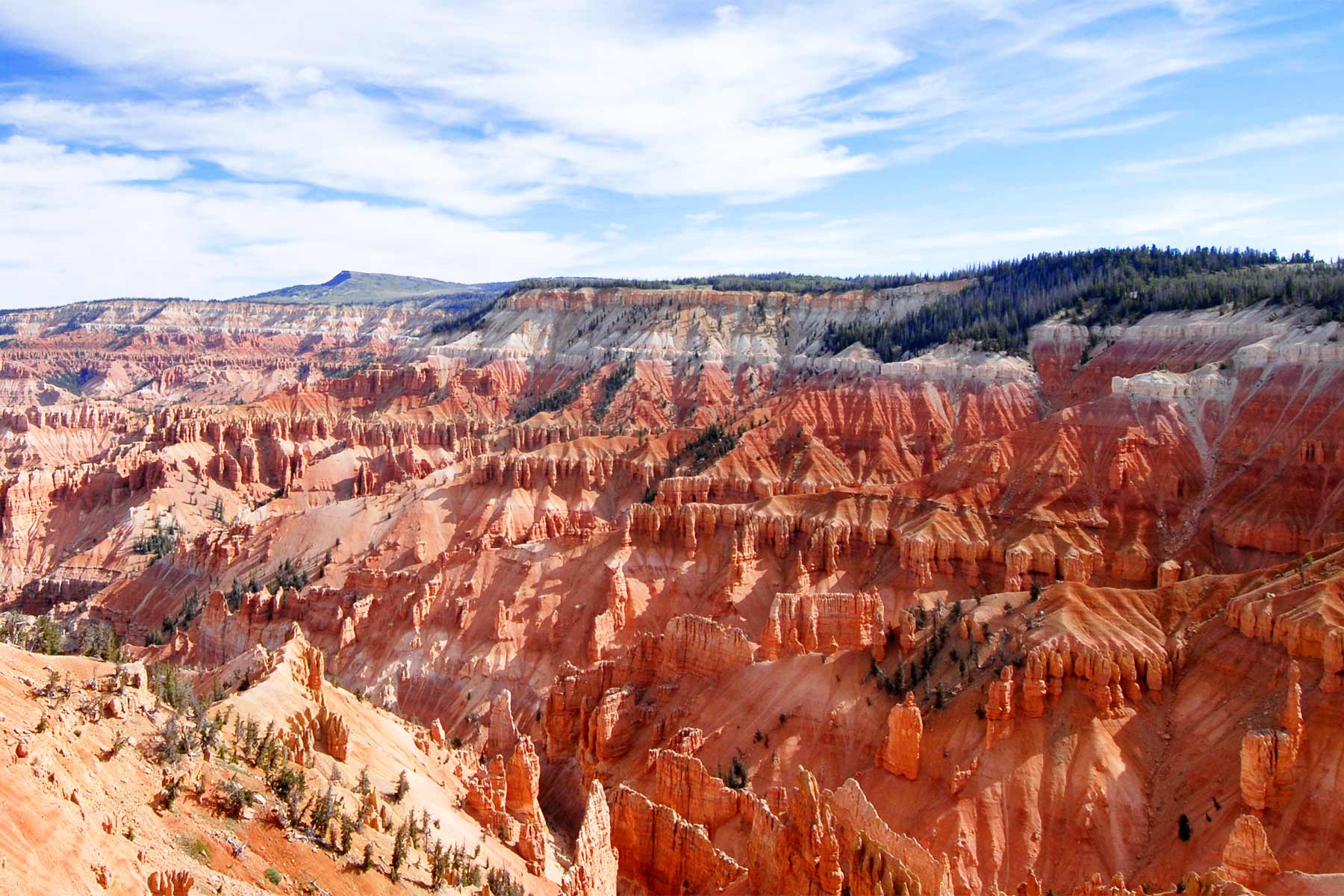
10. Cedar Breaks National Monument
Location: Utah, USA
Managed By: NPS
Size: 6,155 acres
Established: August 22, 1933
Overall Score: 32/50
Located atop the exceedingly scenic region known as the grand staircase, Cedar Breaks National Monument encompasses a spectacular red rock amphitheater amidst Utah’s desert high country.
The monument is rich with flora and fauna, including vast stands of evergreens and aspen, wildflowers, and abundant wildlife. Cedar Breaks can often be overshadowed by its more popular neighbors including Zion and Bryce Canyon National Parks, but is well worth a trip by itself.

11. Hovenweep National Monument
Location: Colorado & Utah, USA
Best Resources:
Managed By: NPS
Size: 784 acres
Established: March 2, 1923
Overall Score: 32/50
One of the few national monuments that spans multiple states, Hovenweep National Monument protects six prehistoric villages constructed nearly 3,000 years ago. The fact that the Puebloan ruins of Hovenweep are still standing today is a testament to the skill of the builders.
Folks visiting Hovenweep National Monument should know that the monument is splintered into five isolated tracts of land. The driving distance between the furthest points however, (the Cajon Group to the Cutthroat Castle Group) is only 25 minutes.
I recommend seeing the Square Tower Group as the most impressive of the ruins. While in the area be sure to check out Canyon of the Ancients National Monument (also included on this list).
Visiting Hovenweep can be a bit of a challenge as it is a remote national monument located in the four corners region of Colorado and Utah. The closest sizable city is Durango, Colorado at just under two hours away. The closest major city to Hovenweep is Albuquerque despite being just under 5 hours away.
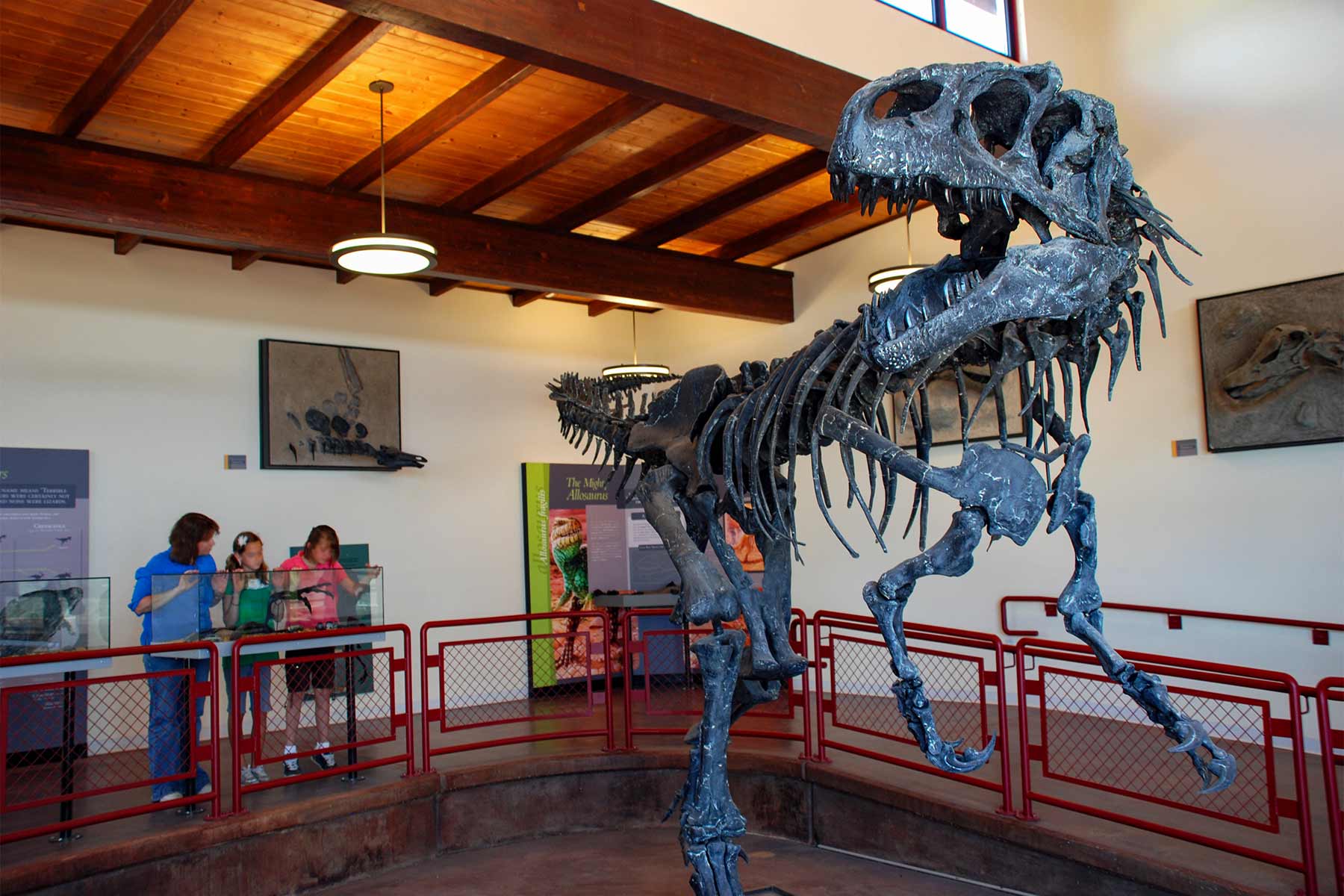
12. Jurrasic National Monument
Location: Utah, USA
Managed By: BLM
Size: 850 acres
Established: March 12, 2019
Overall Score: 28/50
One of the newest national monuments, Jurassic National Monument protects the Cleveland-Lloyd Dinosaur Quarry which contains the largest concentration of Jurassic dinosaur fossils ever found.
The monument is very remote and fairly small at just 850 acres, but it has three nice hiking trails (each around 2 miles) offering beautiful views and opportunities to see petroglyphs.
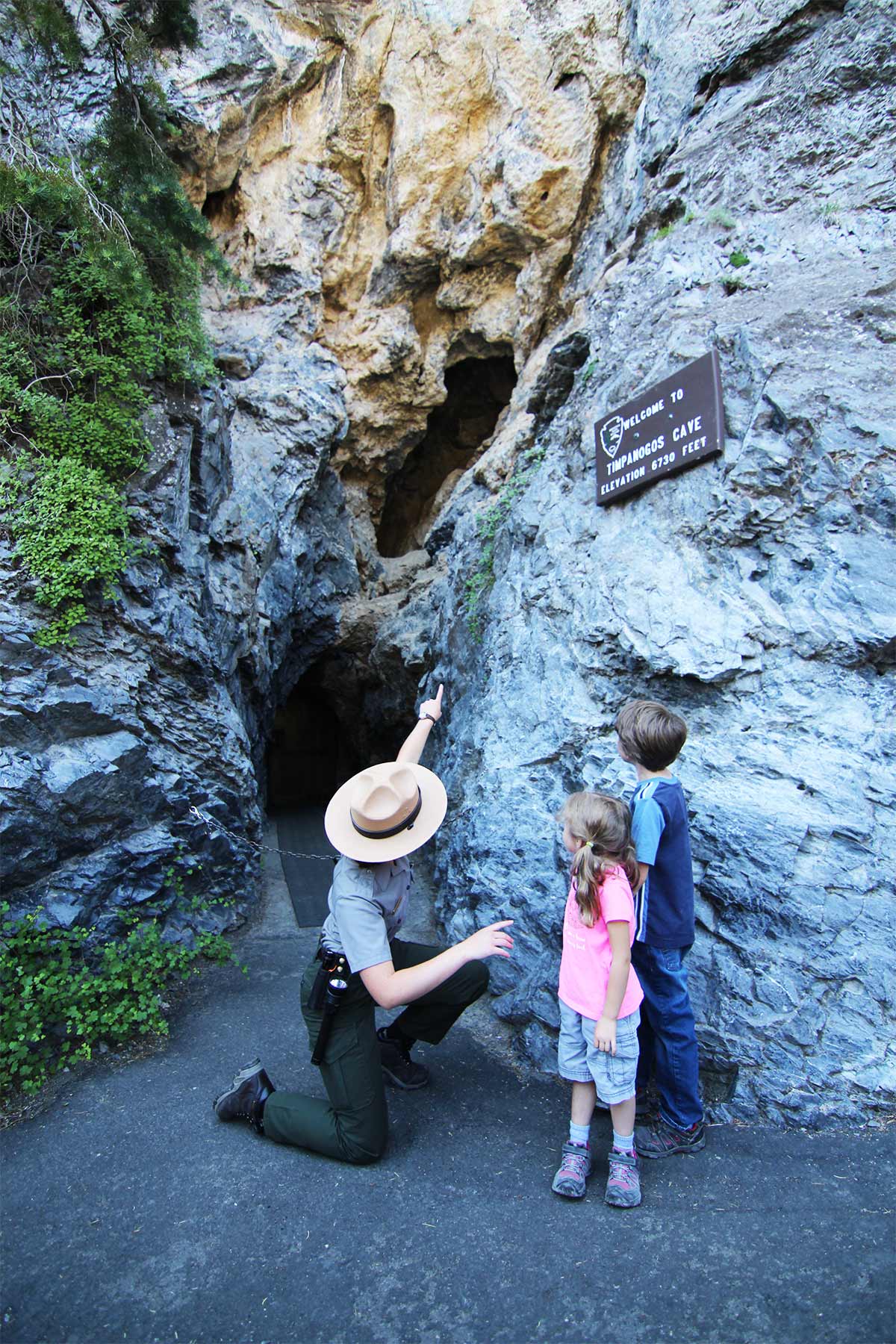
13. Timpanogos Cave National Monument
Location: Utah, USA
Best Resources:
Managed By: NPS
Size: 250 acres
Overall Score: 27/50
Timpanogos Cave National Monument preserves a spectacular cave system minutes from Salt Lake City.
The caves feature numerous colorful and unique formations and offer visitors a glimpse of the incredible natural world beneath our feet.
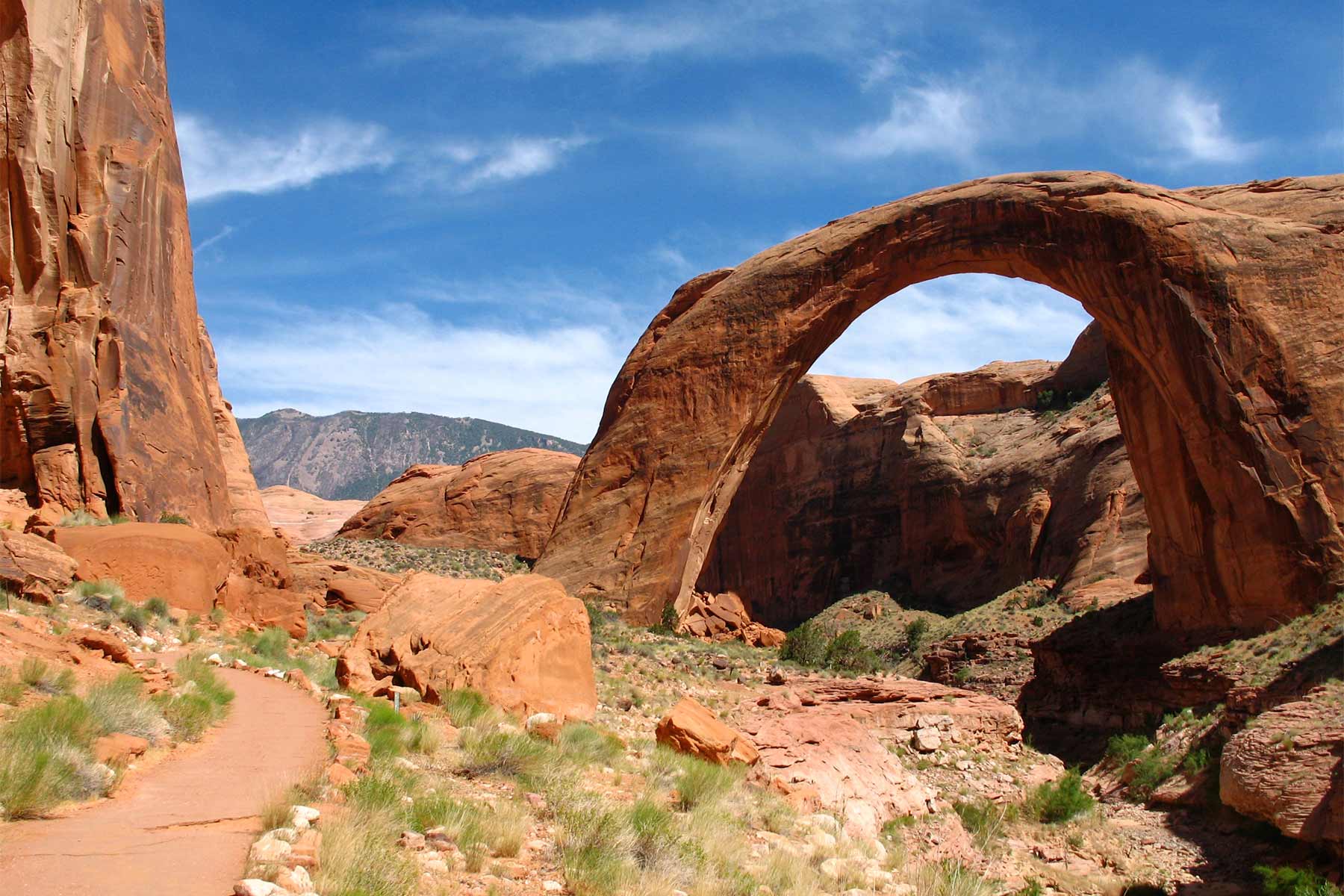
14. Rainbow Bridge National Monument
Location: Utah, USA
Managed By: NPS
Size: 160 acres
Established: May 30, 1910
Overall Score: 23/50
At 290 feet tall, 275 feet wide, and a thickness of 42 feet at the top, Rainbow Bridge is one of the largest natural bridges in the world. That’s pretty cool!
Beyond that, the arch itself is breathtakingly beautiful and absolutely massive in person located in the Lake Powell region of Utah.
So you’re probably asking yourself why a monolith like this has such a low ranking? Access.
Getting to the monument is actually easy… if you have a boat in Lake Powell. If this is the case you can pull your boat right up to the trailhead and hike an easy mile to get there.
Otherwise, and for most of us, getting there involves an arduous multi-day hike through the desert after obtaining a permit from the good folks at the Navajo Nation.
8 Day Utah National Parks Itinerary: Utah Road Trip Route
This route is a basic loop with a terminus in Salt Lake City and a first stop of the Moab parks (Arches & Canyonlands).
For a more in-depth look check out our article, [EPIC] UTAH National Parks ROAD TRIP of a Lifetime (+ Itinerary)
Day 1 Utah National Parks Itinerary: Salt Lake City to Moab + Arches Sunset (3.5hrs drive)
- National Parks: Arches
- Sunset: Lower Delicate Arch Viewpoint (Arches)
Day 1 of your itinerary will largely be spent driving from Salt Lake City to Moab which will be your home base for day trips into Arches & Canyonlands.
Depending on what time your flight gets in and what time you get to the park you’ll hopefully have time to see a sunset.
I recommend Lower Delicate Arch viewpoint in Arches National Park for your Day 1 sunset. It’s far less crowded than Delicate Arch which is better to hike to in the morning.
Spend the night at a hotel in Moab (see above) or camp outside the national park in one of the many beautiful campgrounds along the Colorado River.

Day 2 Utah National Parks Itinerary: Arches & Canyonlands
- National Parks: Arches & Canyonlands
- Sunrise: Upper Delicate Arch Viewpoint (Arches)
- Sunset: Green River Overlook (Canyonlands)
Day 2 of your itinerary starts with a sunrise at Upper Delicate Arch viewpoint in Arches National Park. I recommend packing a lunch to maximize your time in the park!
Morning
Check what time the sunrise is in Moab beforehand and start the hike at least 45 minutes before the sun is set to rise (I recommend an hour). Bring headlamps and watch closely for the easy to miss signs.
After the sunrise continue toward the far end of the park and check out the Fiery Furnace, Sand Dune Arch, and Skyline Arch before stopping for lunch (if you packed one) at the Devils Garden Trailhead (in the car or on benches).

Afternoon
After lunch check out the Devils Garden area and be sure to see Landscape Arch (hard to miss) before heading back toward the park entrance. On your way back out of the park check out Double Arch & Turret Arch, as well as Park Avenue.
If you’re feeling up to it (and have time) I highly recommend heading over to Green River Overlook in Canyonlands National Park for sunset (50 minute drive).
Green River Overlook is one of the most mesmerizing national park views I’ve seen.
Day 3 Utah National Parks Itinerary: Canyonlands to Capitol Reef (3hrs)
- National Parks: Canyonlands & Capitol Reef
- Sunrise: Mesa Arch (Canyonlands)
- Sunset: Sunset Point (Capitol Reef)
Day 3 starts with one of the best sunrises in Utah – the world famous Mesa Arch sunrise. The trail is short but be sure to get to the arch at least 30 minutes early for a good spot (it will be crowded).
After Mesa Arch I recommend the Upheaval Dome hike to the first overlook. On your way back out of the park be sure to stop off and check out the epic Shafer Trail Viewpoint.
Drive to Capitol Reef
After Canyonlands you’ll drive back the way you came (boring, I know but trust me, it’s worth it) and head on to Capitol Reef National Park. The route to Capitol Reef is pretty cool, especially as you get closer to the park itself.
Pro-tip: Pack a lunch and eat along the way to Capitol Reef National Park. Otherwise you’ll have to drive back in to Moab or get food in Torrey which is a 3 hour drive. There’s not much along the way.
If you have time, catch a sunset at Sunset Point in Capitol Reef. Epic views at the beginning of the park.
Capitol Reef National Park has Fruita Campground where you can camp (if they have spots). Alternatively there is a great car camping spot just outside of the park which I’ve pinned here.
If you’re looking for hotels, Torrey is the spot and I’ve listed them above.

Day 4 Utah National Parks Itinerary: Capitol Reef & Bryce Canyon
- National Parks: Capitol Reef & Bryce Canyon
- Sunrise: Panorama Point
- Sunset: Fruita Barn
Day 4 of your Utah National Park road trip starts with a sunrise at Panorma Point. If you’re tired, this is an OK one to skip.
I LOVE Capitol Reef National Park because it is the least crowded which is why I recommend spending nearly a full day here.
Hikes to check out include (in order of best to least):
- Cassidy Arch
- Hickman Bridge
- Grand Wash
- Cohab Canyon

Capitol Reef to Bryce Canyon (2hrs)
From Capitol Reef I recommend you take the scenic route, Utah’s Hwy 12 which is one of the most spectacular highways in America.
This drive is one of the absolute highlights of the trip and is not to be missed but it is not the natural way your GPS will route you. Be sure to add Escalante, Utah as a pin to your route or risk missing this stunner.
Sunset & Sleep
If you arrive at Bryce Canyon with enough time for sunset then check out the aptly named Sunset Point.
Bryce Canyon has a beautiful lodge if you’re looking to splurge (book way in advance), also plenty of hotel options in Bryce, Utah.
Bryce Canyon also has 2 big campgrounds inside the park (book in advance).
Day 5 Utah National Parks Itinerary: Bryce Canyon National Park
- National Parks: Bryce Canyon & Zion
- Sunrise: Inspiration Point (not Sunrise Point)
- Sunset: Canyon Junction Bridge
Day 5 starts in beautiful Bryce Canyon National Park which is quite compact compared to some of the others.
It is also the coolest in temperature as the visitor center sits at 9100 feet elevation so pack a jacket!
Start your morning with a brisk sunrise at Inspiration Point which is superior to Sunrise Point in my humble opinion (also less crowded).
From there, hike the Navajo Loop Trail in reverse ending with the impressive Wall Street section (wow).
If you feel like extending this hike then I highly recommend adding the Queens Garden loop or a piece of the Peekaboo Canyon Trail.

Afternoon
After this you can either exit the park to get a head start on Zion if you’re short for time or continue on in to Bryce.
I find the complex of trails nearest the visitor center to be the best by far so it’s totally fine to leave it here in my opinion.
If you want to see more then continue down N Bryce Canyon Road past Bryce Natural Bridge (roadside stop) to the end of the road (30 minute drive).
Here you’ll find the Bristlecone Pine Trail which I was thrilled to discover and dissapointed to hike.
The Bristlecones here are hard to spot and mostly dead (nothing like what you’ll see at Great Basin).
Bryce Canyon to Zion (1.5hrs)
From Bryce Canyon the drive continues through the Dixie National Forest (which is well worth the visit in its own right – a fraction of the visitors and equally stunning scenery) and the beautiful Red Canyon area (featured in our film below) to the east entrance of Zion National Park.
Upon entering the east entrance of Zion via the Zion-Mount Carmel Highway the scenery changes drastically in a wonderful way.
Watch out for Bighorn sheep as you near the third tunnel!
Sunset
After passing through this tunnel visitors are given their first look at the epic canyons of Zion.
If you make it to Zion in time, catch a sunset from around the Canyon Junction Bridge (famous view of the Watchman).
You can either stay in a hotel in Springdale (the closest city) or camp in the park (extremely limited and hot) or car camp/boondock outside the park off Smithsnonian Butte Road (BLM).
Day 6 Utah National Parks Itinerary: Zion National Park
- National Parks: Zion
- Sunrise: Skip or Canyon Overlook
- Sunset: Canyon Junction Bridge
Morning
Day 6 starts with a great opportunity to skip the sunrise (Zion is not full of epic sunrises).
I recommend starting the day early with the epic Narrows hike (one of my all time favorites).
If you don’t pack water shoes then you can rent some in Springdale. This will slow you down and add expense so I recommend bringing something.
In order to hike the Narrows you need to take the Zion shuttle all the way to the last stop.
The first shuttle leaves the visitor center at 6 am during the spring & summer (8am in the winter).
In spring/summer at the shuttle station at least 30 minutes early at 5:30 (I know, woof).
It will be shockingly crowded at this hour.Making the first shuttle makes a big difference (or at least one of the first).
After The Narrows I recommend popping right over to Angels Landing (if you’re up for it) as it will still be early enough to get in before most of the crowds.

Afternoon
After Angels Landing, eat lunch (packed or at the Zion Lodge). Big Bend is great for a quick stop and the Grotto is great although many of the trails here are currently closed.
Once you’re back at the visitor center I recommend heading over to Zion-Mt Carmel Highway and exploring the trails over here, especially Canyon Overlook.
From here drive over to the lesser-traveled Kolob Terrace region of the park for late afternoon exploring & sunset.
For sunset I recommend my favorite sunset in the park, Lava Point Overlook.
If possible, try and grab a site at Lava Point Campground which only has 6 sites and is the best in the park. Otherwise you’ll have to head back to La Verkin or Springdale for a hotel.
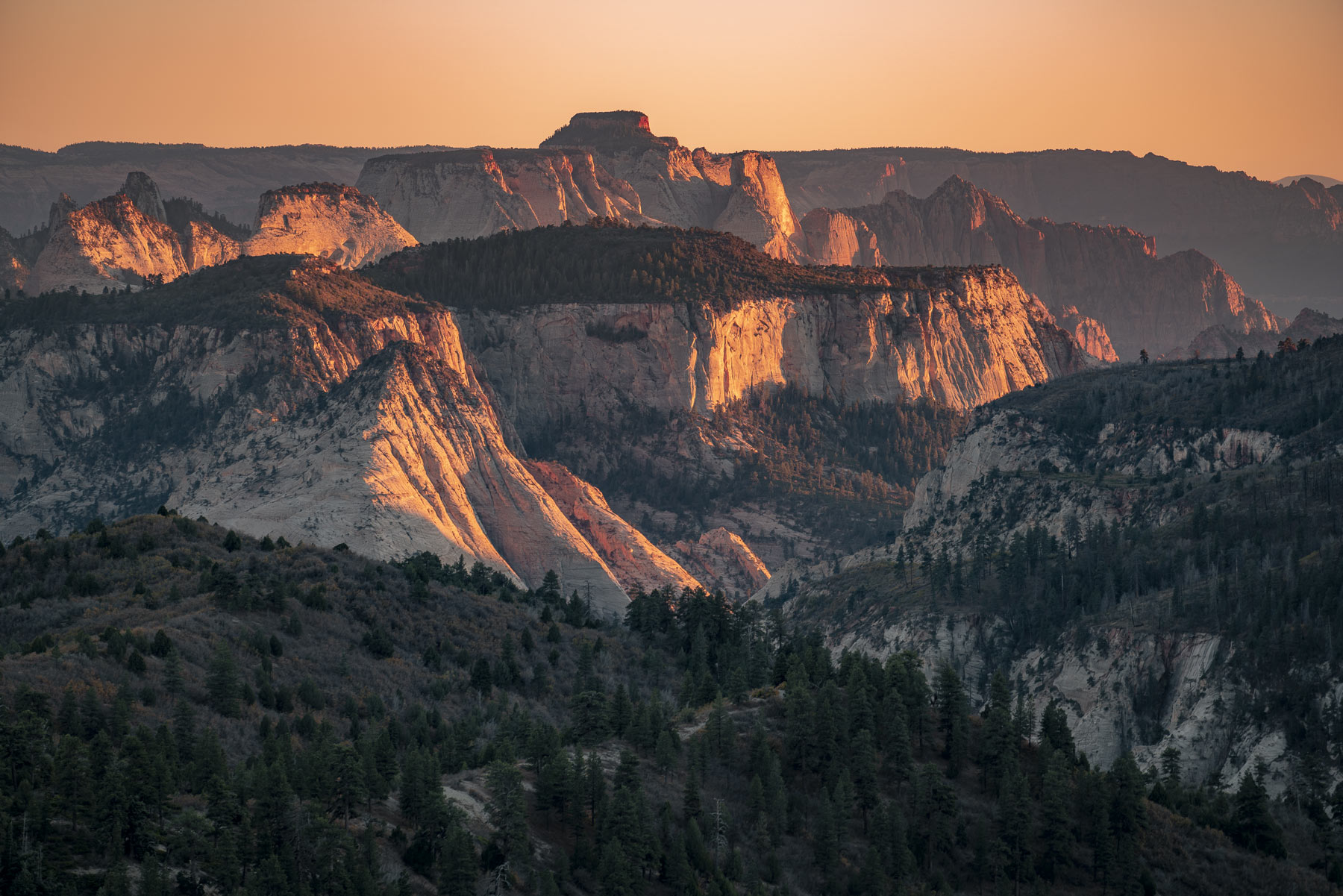
Day 7 Itinerary: Zion National Park
- National Parks: Zion
- Sunrise: Kolob Terrace
- Sunset: Timber Creek Overlook
Day 7 starts in Kolob Terrace for sunrise (if you’re tired this is an OK one to skip. Kolob Terrace Road offers great chances to explore Zion National Park without the crowds.
Things to explore in Kolob Terrace include:
- Hop Valley Trail
- Lava Point Overlook
- Hoodoo City
- Pine Valley Peak
Afternoon
After a morning of exploring Kolob Terrace head over to Kolob Canyon for afternoon activities and another epic sunset. You’ll have an option to grab a bite to eat in La Verkin on the way to Kolob Canyon.
Kolob Canyon is another lesser-traveled section of Zion that is worth a visit. I recommend hiking Taylor Creek before making your way to the “top” of this section.
Timber Creek Overlook is oen of the best places in Zion to catch a sunset. The trail is short and epic.
After sunset head over to Cedar City for a relatively inexpensive hotel.

Day 8 Itinerary: Cedar City to Salt Lake City (3.5 hours)
The last day is basically just making your way back to Salt Lake City to return the rental car and flying home. Ah but the memories!
Ever Considered the 5 Utah National Forests?
1. Dixie National Forest
I can not recommend visiting this national forest any more strongly. It is an incredible and overlooked piece of Utah that has a tiny fraction of the visitors of the Utah Mighty 5.
Nestled in the rugged southwestern corner of Utah, Dixie National Forest spans nearly 2 million acres of jaw-dropping scenery and endless vistas.
Join us as we take you on a visual journey through alpine lakes and forests of aspen to vast red deserts and dazzling formations of sand and stone. This is Dixie. Filmed primarily in 8K.
Located in southwestern Utah, the Dixie National Forest spans almost two million acres and stretches for nearly 170 miles, making it the largest national forest in the state.
Winding your way through the stunning landscapes of southern Utah, the Dixie National Forest offers spectacular scenery that easily rivals that of it’s neighbors Bryce Canyon, Zion, and Capitol Reef National Parks.
2. Uinta Wasatch Cache National Forest
The Uinta-Wasatch Cache is one of the most stunning and unique regions in the country and happens to also be located in Utah.
Explore mountains, valleys, forests, canyons, and meadows that are home to some of north america’s most treasured animals and landscapes.
3. Ashley National Forest
The Ashley National Forest is yet another incredible Utah destination located in the northwestern corner of the state.
Explore gorges, valleys, forests, deserts, and meadows as we take you from sunrise to sunset in this remote and beautiful landscape.
4. Fishlake National Forest
Resources: Fishlake National Forest Guide
5. Manti-La Sal National Forest
Resources: Manti-La Sal National Forest Guide
Map of Utah’s National Parks
See below map with the locations of all five of Utah’s National Parks.
List of Utah National Parks (Summary)
- Arches National Park
- Capitol Reef National Park
- Zion National Park
- Canyonlands National Park
- Bryce Canyon National Park
- Dinosaur National Monument
- Grand Staircase-Escalante National Monument
- Bears Ears National Monument
- Cedar Breaks National Monument
- Natural Bridges National Monument
- Jurassic National Monument
- Timpanogos Cave National Monument
- Hovenweep National Monument
- Rainbow Bridge National Monument
Why Listen to Us About Utah’s National Parks?
We’re Jim Pattiz and Will Pattiz, collectively known as the Pattiz Brothers. Our goal here at More Than Just Parks is to share the beauty of America’s national parks and public lands through stunning short films in an effort to get Americans and the world to see the true value in land conservation.
You should probably know that we didn’t just make this list up out of thin air. We’ve spent our entire adult lives exploring and filming America’s national parks and public lands. We’ve worked with the National Park Service, the Department of Interior, and the U.S. Forest Service for years creating films on important places and issues.
Our work has been featured in leading publications all over the world and even some people outside of our immediate family call us experts on the national parks.
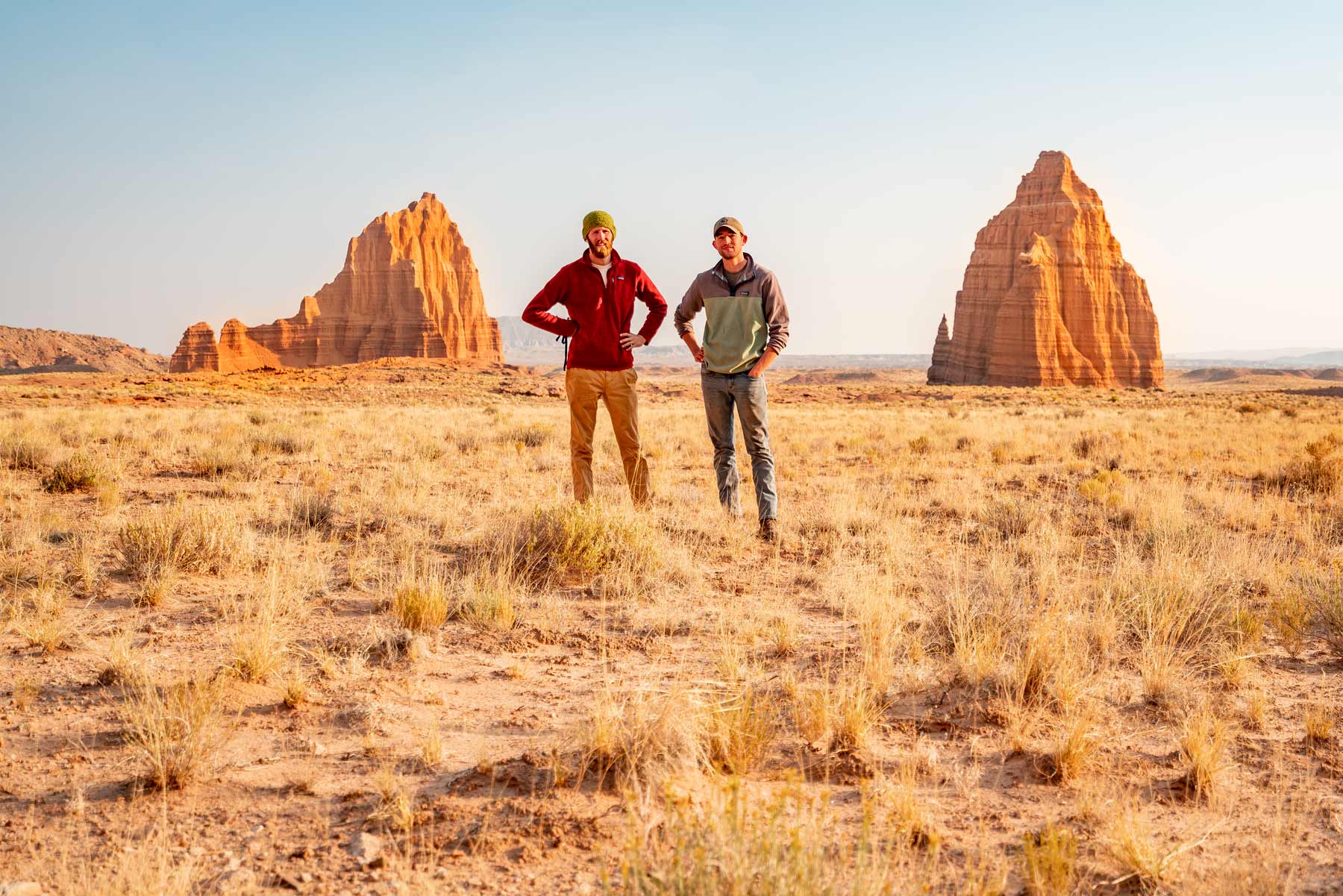
Utah National Parks Map (Printable)

Download: Printable Utah National Parks Map
utah national parks, national parks utah, national parks in utah, national parks of utah, utah national park, list of utah national parks, utah national parks, national parks utah, national parks in utah, national parks of utah, utah national park, list of utah national parks, utah national parks, national parks utah, national parks in utah, national parks of utah, utah national park, list of utah national parks, utah national parks, national parks utah, national parks in utah, national parks of utah, utah national park,
Utah National Parks Ranking Criteria
Now, you might ask how on earth we ranked Utah’s national parks from best to worst. We ranked all of the national parks based on a variety of factors including accessibility, recreational opportunities, crowd sizes, park amenities, and of course, scenic beauty.
Have a look at the breakdown below:
- Accessibility – Is this national park easy to access? We analyzed vehicle access, transportation options, proximity to major airports, lodging and accommodations, conveniences, and other signs of civilization.
- Recreation – Recreation opportunities found in the park like hiking, biking, boating, climbing, etc.
- Crowds – How crowded is this national park? We considered traffic, crowded overlooks & trails, limited campsite availability, lines, etc.
- Amenities – Developed amenities in the park like visitors centers, campgrounds, bathrooms, lodges, etc.
- Scenery – The scenic beauty of the park. Purely subjective of course, but has to be taken into account.
One More Note About Utah National Parks Rankings
You’ll notice that Zion, despite scoring higher than Arches and Capitol Reef via the point system, is ranked lower on this list. That was intentional.
The crowds at Zion during peak season, and much of the rest of the year, are currently a major factor in the overall user experience. Because of this, we’re choosing to rank it #3.

Pin Utah National Parks

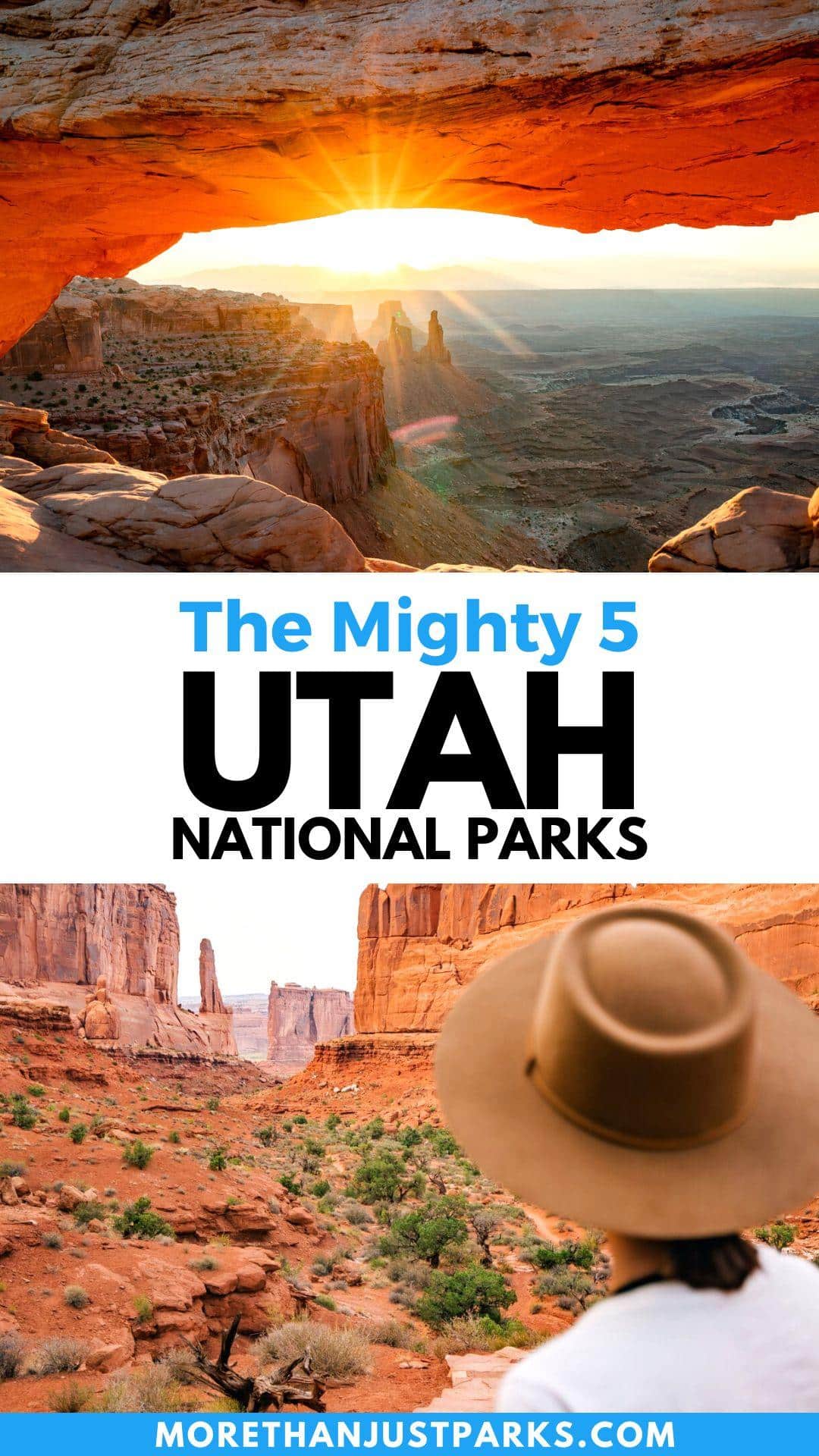
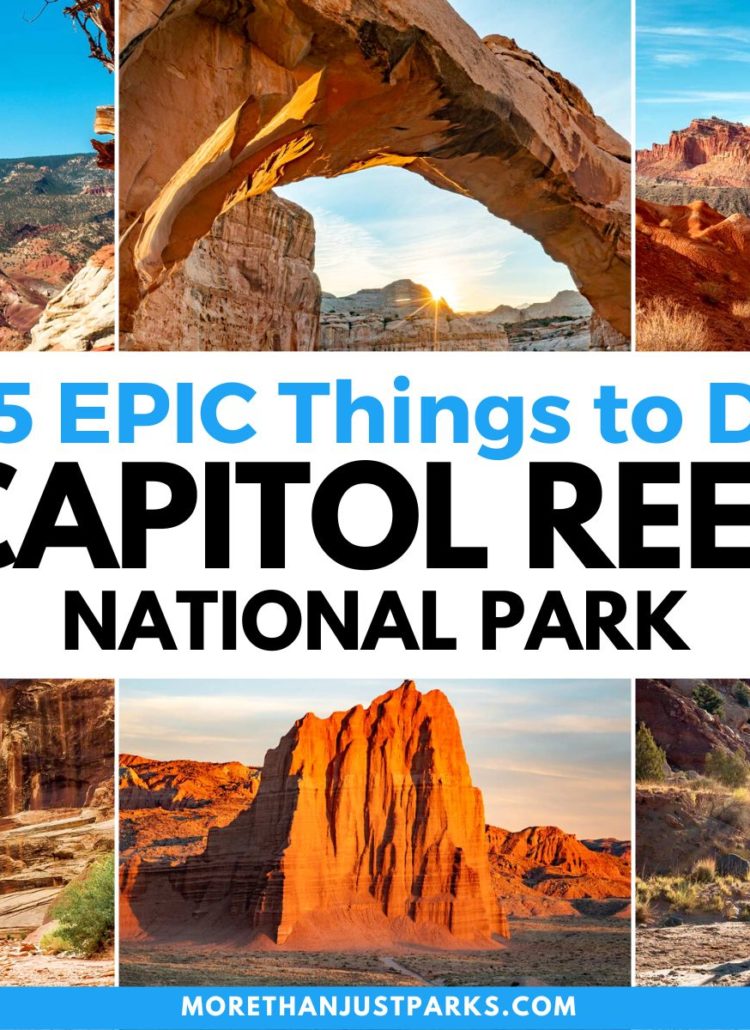
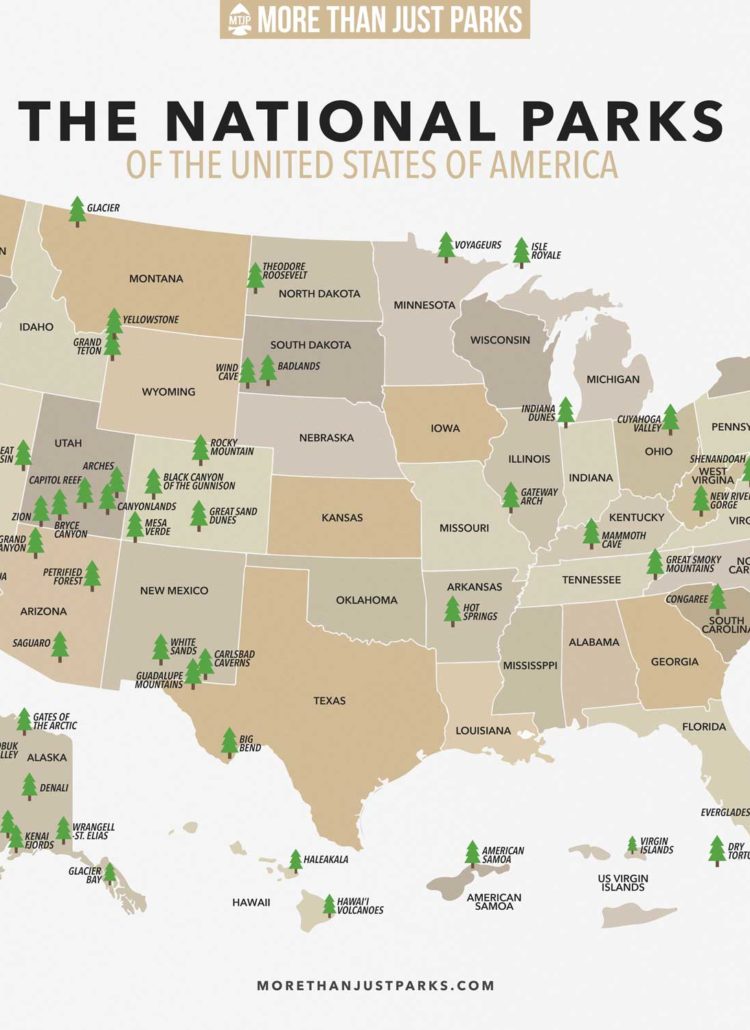
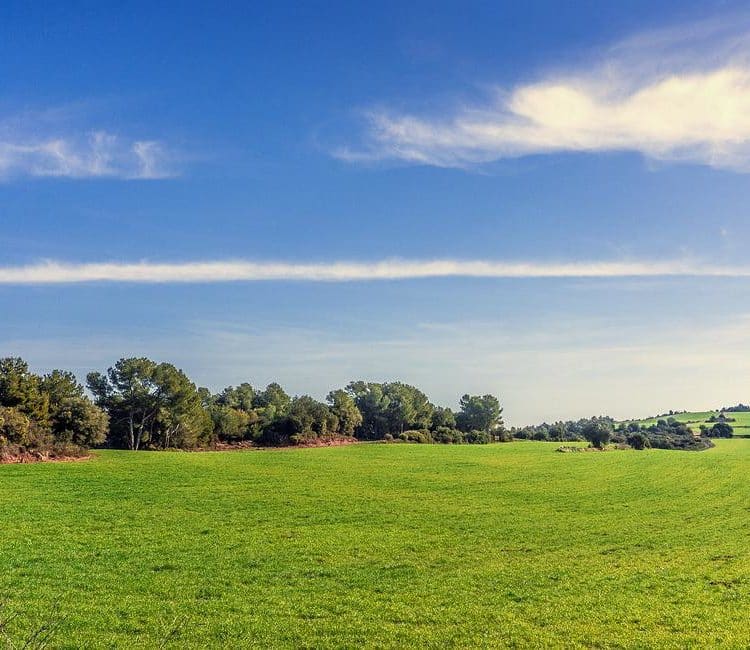


I am fortunate enough to live in Utah, and so have been able to spend time in all five of these parks in the past year. My ranking would be a bit different. I would rank them as 1) Canyonlands, 2) Capitol Reef/Zions 4) Bryce and 5) Arches.
Canyonlands just has this vast feel to it that I really like. I feel like I could go back to Canyonlands again and again and always have new places to explore and see. It isn’t very crowded, but it’s still close to Moab. Capitol Reef and Zions are both beautiful, and Zions just has a lot of unique and iconic features that are spectacular. It is just ridiculously crowded.
Last summer, at the height of COVID restrictions in the park, I went and hiked the Narrows and got in line with the car to be able to park up there at 2:30 am to get a spot, and I still didn’t quite get a spot in the main parking lot (I got a spot in a pull off a quarter mile from the main narrows parking lot). Kolob Canyon feels just as spectacular though, but without the crowds.
Capitol Reef has a majestic but also cozy feel to it that is cool, but it also feels like there is a lot to explore. The Cassidy Arch there is fun as it is actually an arch they let you walk out on and can stand on top of. Bryce Canyon is the one that I have spent the least amount of time in recently, but it is still very pretty and hiking down in the hoodoos is a cool experience. It feels a lot smaller than the first three though, and it feels like you can pretty well see the park in a day.
And this brings me to Arches. The arches there are really cool, it’s a unique and interesting geological feature. But, Arches feels like a small park. Besides the arches there isn’t much to see there, and at least my experience there has been drive to one arch and hike for a bit, drive to the next and see it, repeat. It doesn’t have the vastness that I really like from being in nature and in the national parks (like Canyonlands).
I guess to me Arches just feels like a gimmicky road side attraction, come see this amazing arch, but then there isn’t much else there. I agree that they should be protected and its worth going there once, but after that first time I feel like I’ve seen the whole place.
After hiking in all 5 parks several times each, I would argue, for hikers, the order from best to worst would be Bryce, Capitol Reef, Zion, Canyonlands, Arches.
I don’t think ranking national parks a good idea. It’s like parents to rank their kids from best to worst, which is awkward and unfair. If you really want to, ranking to specific items (crowds, affordability, hiking/backpacking, scenery, camping, ranger programs……) could be better.
Thanks so much for the feedback! We are always trying to improve our articles 🙂
This is to serve more as a guide for folks who are interested in visiting Utah’s national parks so they can compare and contrast the pros & cons of each one themselves.
Cheers,
Will
Has anybody done any of these parks with kids?
I have not but happy to try and help you with any questions you might have!
Best,
Will
We would love to see some of the National Parks with my 18 year old daughter over her break. We only have a week – 3/26 – 4/3. I would love your suggestions as to where to fly in and out if different than Salt Lake and what works best in this time frame. The Capital Reef has availability and looks amazing. What would you suggest seeing and where to stay if we only have a week?
Hi Cindy!
Thanks for reaching out. How fun! Capitol Reef is actually my favorite Utah National Park for many reasons the first of which is the smaller crowd sizes. I’m actually working on an article right now on the best things to do in Capitol Reef National Park. I’ll add a link here to the article when I finish later today!
Best,
Will
Hey Cindy,
Update here – I’ve just finished the article on Capitol Reef! Let me know if you have any more questions. I recommend flying into either Salt Lake City or Las Vegas and driving out depending on which one has cheaper flights/rental car combo.
If you’re looking for a post more geared toward the Utah National Parks Road Trip I’ve written one on that as well.
Hope this is helpful!
Best,
Will